- Custom Tillers

Handcrafted sailboat tillers
Order by boat model or custom size. Any style can be built by providing a few simple dimensions.
Welcome Sailors!
THIS IS THE HOME OF WOOD SAILBOAT TILLERS. WE OFFER QUALITY TILLERS FOR MANY BOAT MODELS SUCH AS CATALINA, HUNTER, J-BOAT, PEARSON, AND MORE. CUSTOM TILLERS ARE ALSO AVAILABLE. OUR TILLERS ARE BEING USED AROUND THE WORLD BY ALL TYPES OF SAILING ENTHUSIASTS INCLUDING DAY SAILORS, LONG TRIP CRUISERS, AND COMPETITIVE RACERS.
REQUEST QUOTE
PRESS BUTTON BELOW TO PULL UP OUR TILLER ORDER FORM. THE FORM WILL TAKE IN ALL THE NECESSARY INFO THAT WILL BE NEEDED TO QUOTE YOUR TILLER. I WILL BE IN TOUCH SOON WITH PRICING AND TO CONFIRM DIMENSIONS. WE WILL BEGIN WORK WITH YOUR GO AHEAD.
Hi John, Thank you again! The tiller is beautiful and it is a perfect fit. Out sailing Long Island Sound. Doug Mitten-Norwalk, CT
JT, Tiller is beautiful - perhaps too much so, it puts the rest of my boat to shame. Thanks for the quick turnaround. Tom Boussie-Menlo Park, CA
You all did a beautiful job in crafting my new tiller. I am very happy with the finished product. Thank you for your craftsmanship. Frank Porpotage-Sarasota Sailing Squadron
The tiller has arrived. What wonderful craftsmanship! It is absolutely beautiful ... a work of art. Thank you. Paul E. Mottl-Crisfield, MD
The tiller has arrived . . it is absolutely beautiful . ...we are very happy . . awesome workmanship . . thanks you so much..I will install it tomorrow and then it's out sailing again... thanks again for providing such an excellent product. Tom and Kip Klidonas-Delray Beach, FL
Tiller arrived and its a beautiful work of art. Thanks. My boat will be very happy! Leighton Cooney-Auburn, ME
The tiller arrived Thursday and it is a work of art! Thanks very much for your fine workmanship. David Hulse-Chesapeake, VA
Dear JT, Thank you so much! The tiller arrived yesterday and it is gorgeous! It will stand out on this old sailboat and I'm sure it will make her sail even better. Macky Gaines-Vergennes, VT
The tiller you made is beautiful and a perfect fit. Dean Brock-Port Townsend, WA
The tiller arrived last night. It is a work of art. Thanks very much. I will recommend you to everyone I know and will send anything else I need your way. Bill Wesp-Centerport, NY
Hi JT, just letting you know I am very pleased with the quality of work you guys have done. I also appreciate the time you and your dad took to get the peculiar measurements precise. Dan Scheffel-Kansas City, MO
Thanks John, I know you've made my husbands Christmas very special. Linda Scheffield-Florida
John, it looks great. The craftsmanship is excellent and made in America! Perfect. Thanks again. Art Buehler
Recieved, thank you. It came out beautiful. I can't wait to get it in my fathers hands. Derek Basini-Rockville Centre, NY
It was delivered yesterday. It's perfect. Thanks so much for your work. I will recommend you to all that may need a tiller. Leslie Dietsch-Erie, MI
Good morning, the tiller arrived and it is beautiful. Jeff Brunson- Mt. Pleasant, SC
Copyright © 2018 ANY TILLER - All Rights Reserved.
Powered by GoDaddy
Cookie Policy
This website uses cookies. By continuing to use this site, you accept our use of cookies.
- BOAT OF THE YEAR
- Newsletters
- Sailboat Reviews
- Boating Safety
- Sails and Rigging
- Maintenance
- Sailing Totem
- Sailor & Galley
- Living Aboard
- Destinations
- Gear & Electronics
- Charter Resources
- Ultimate Boat Giveaway

Simple Self Steering
- By Webb Chiles
- Updated: December 18, 2017
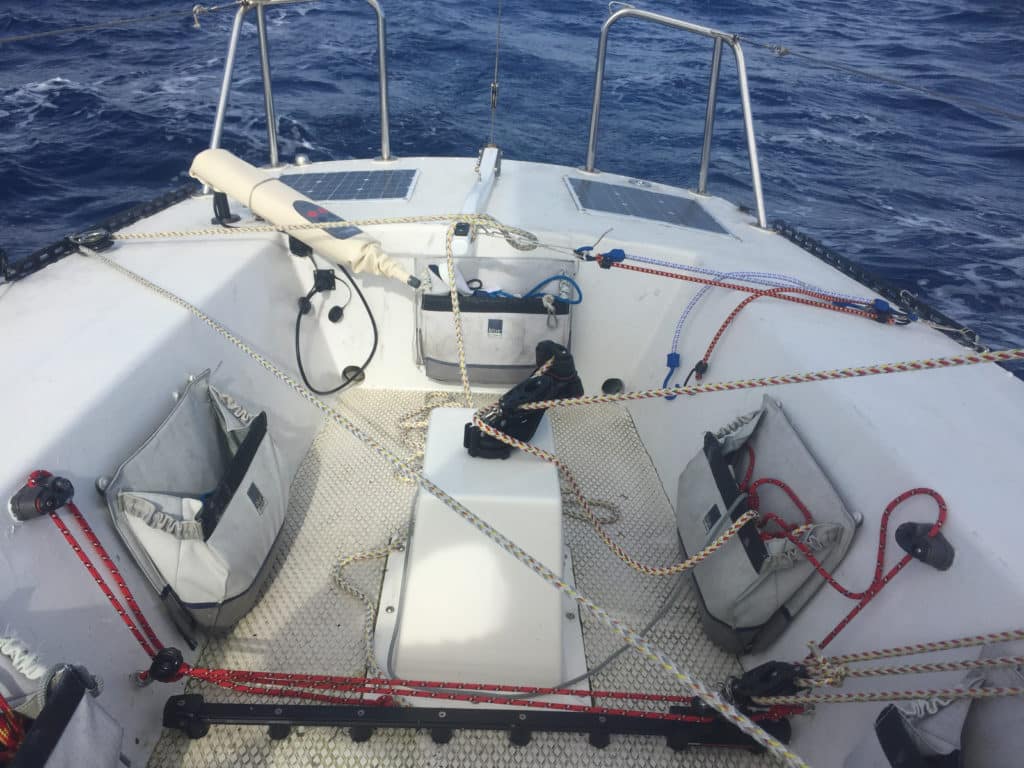
Halfway across the Tasman Sea, during a spring 2016 passage from Opua, New Zealand, to Bundaberg, Australia, aboard my Moore 24, Gannet , I observed that the ship’s batteries were running down. Initially, I attributed this to a combination of sun position, our course and the wind direction, which resulted in four of the six deck-mounted solar panels being in shade for most of the day, leaving only the two near the stern exposed to direct sunlight. Later, when I was able to test the circuit from each solar panel individually, I discovered that one of the stern panels had failed, the fourth of the six to do so since leaving San Diego two years earlier.
Whatever the cause, the consequence was that I could not continue using a tiller pilot to steer, so I did what I have done for tens of thousands of miles on other boats in the past and went to sheet-to-tiller self-steering. Of the 9,000 miles I sailed on Gannet in 2016, about 7,000 were under sheet-to-tiller.
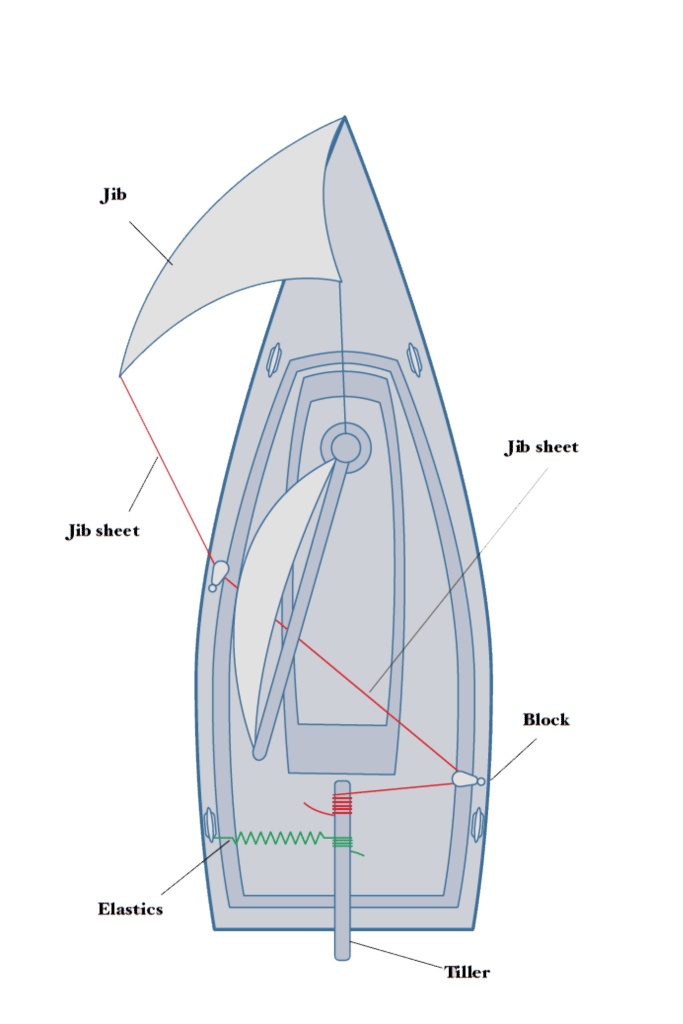
There may be other versions of sheet-to-tiller steering, but I have always run the jib sheet to the windward side of the cockpit and then to the tiller, balanced on the leeward side with bungee cords or surgical tubing. This works from a close reach to a broad reach, and every boat I have owned could be sailed to windward just by balancing the sails and tying down the tiller.
After my Aries vane was torn apart in the Southern Ocean by the strongest wind I had ever encountered on my 37-foot cutter, Egregious , I used the storm jib set as a staysail as the steering sail. On my 18-foot open yawl, Chidiock Tichborne , I used the jib. On my 24-foot sloop, Gannet , the furling jib steers.
The necessary gear is inexpensive and probably already on most boats: a few blocks, 9 or 10 feet of roughly 1/8-inch cordage, and bungee cords of varying elasticity or surgical tubing. I use a combination of bungee cords and surgical tubing, which can be bought from Amazon. Surgical tubing has the advantage of being infinitely adjustable, but deteriorates on long passages, presumably from exposure to sunlight, and is sometimes difficult to untie.
The first step is determining how to run the steering sail sheet to the windward side of the cockpit. Whatever sail is used, the sheet is initially trimmed through its usual leeward block, then to a block on the windward side of the cockpit beside the tiller. On flush-decked Gannet there are no obstructions. I tie the blocks to the toe rail. On other boats, one or more intervening blocks may be necessary. You want to reduce friction, so the fewer the better.
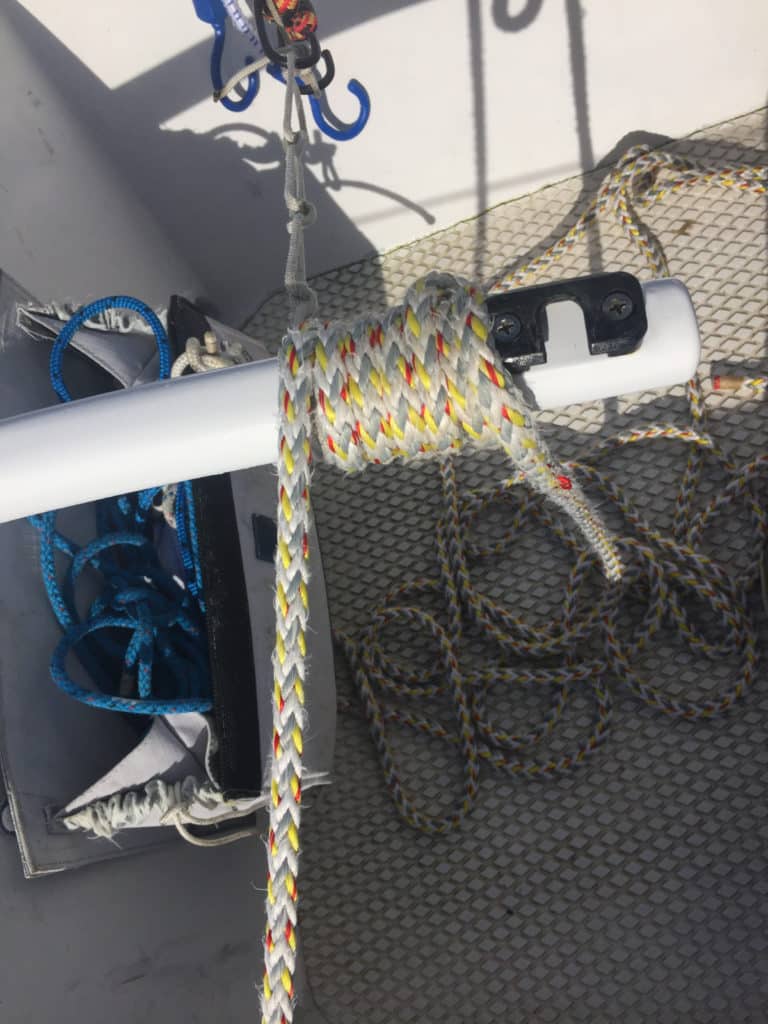
Next, cut the cordage into approximately 3-foot lengths. Take one of these and tie the middle of it to the tiller with a clove hitch. Then take the two ends and tie as many approximately 2-inch-diameter loops as you can. I use reef knots. You should end up with four or five loops.
The two remaining lengths of line are tied off to strong points near where the blocks to lead the jib sheet are. Tie a series of loops in them as well. The purpose of the loops is to provide adjustment for the bungee cords. Give yourself plenty of room when you first try sheet-to-tiller steering. Put the boat on a reach. A broad reach is probably easiest.
I have never been able to get the sheet-to-tiller arrangement to work without part of the jib and part of the mainsail set. It wouldn’t work on Chidiock Tichborne with jib and mizzen, nor on Egregious or Gannet with jib alone. So you need the jib and at least part of the main set. The jib is trimmed normally. Run the tail of the jib through the windward cockpit block. Connect two bungee cords to the leeward side of the tiller just tight enough so that when unstretched they hold the tiller a couple of inches to leeward. Uncleat the jib and remove it from the winch. This will require hand-holding the sheet briefly. You don’t want too big a steering sail. Hand-trim the sail so it is drawing properly. Wrap the sheet around the tiller three or four times and tie it off with a slippery hitch.
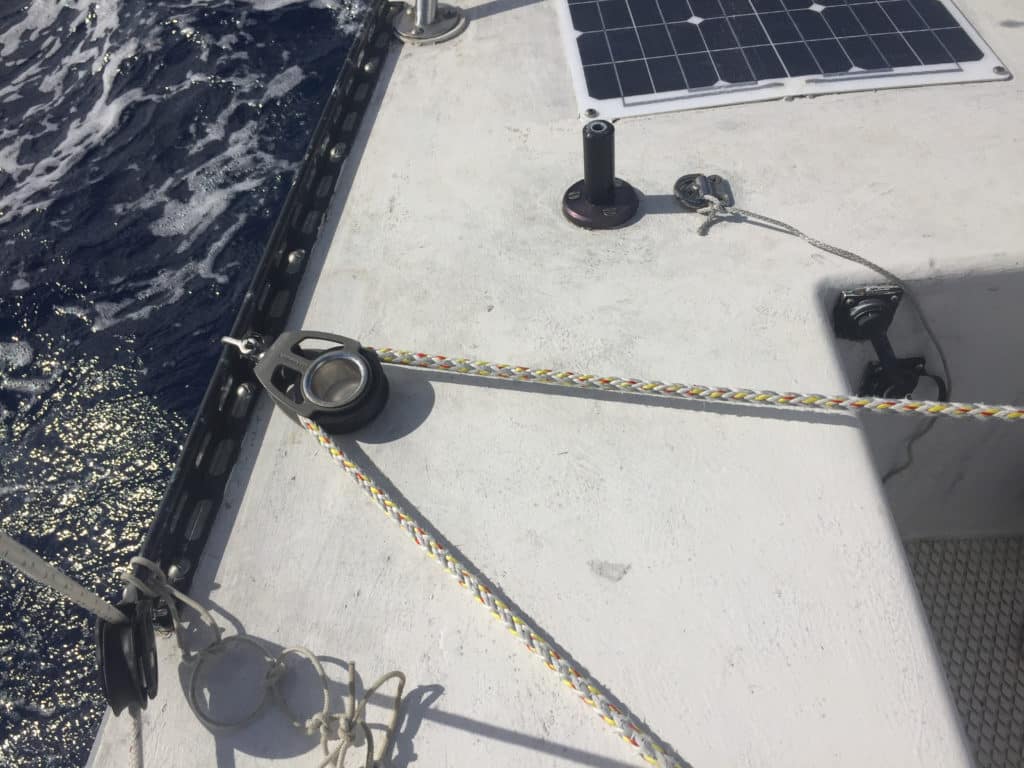
And then it is just about finding the right balance.
The jib will pull the bow off the wind, and the mainsail and the bungee cords are going to be pulling it up. You might need to ease or tighten the mainsheet. You might need only one bungee cord. In strong wind, you might need four. You might need to move one or more cords to loops closer to the tiller or farther away. If your steering sail is set on furling gear, you might need to reduce or increase sail area.
When you get it right, there is beauty to sheet-to-tiller, your boat moving through the water, steered silently by balanced natural forces.
Tiller pilots have their place. I use one, when any of mine are working, to sail with an asymmetrical; in extremely light wind; and when the wind is strong and aft, sailing under jib alone or bare poles. But that’s it. At practically no expense you have freed yourself from the tyranny of the tiller. And tiller pilots.
On the closing stages of his sixth circumnavigation, this one aboard his Moore 24, Gannet, Webb Chiles left the boat in Marathon, Florida, last fall and winter, where she survived Hurricane Irma. Later this year, he plans to sail Gannet *back to San Diego via the Panama Canal to complete his latest lap of the planet. *
- More: autopilots , How To , self steering , webb chiles
- More How To

Grease the Wheels of Your Boat: A Guide to Proper Lubrication

A Bowsprit Reborn: A DIY Renovation Story

Rigging Redo: Our Switch to Synthetic

Top Tools for Sailboat Cruising: Must-Have Gear for 2024

From Paradise to Medical Emergency: A Bahamas Nightmare Turns Lesson Learned

Free Medical Advice: The Unwarranted, Unprofessional Edition

Gatekeepers of the Waterway

- Digital Edition
- Customer Service
- Privacy Policy
- Terms of Use
- Email Newsletters
- Cruising World
- Sailing World
- Salt Water Sportsman
- Sport Fishing
- Wakeboarding
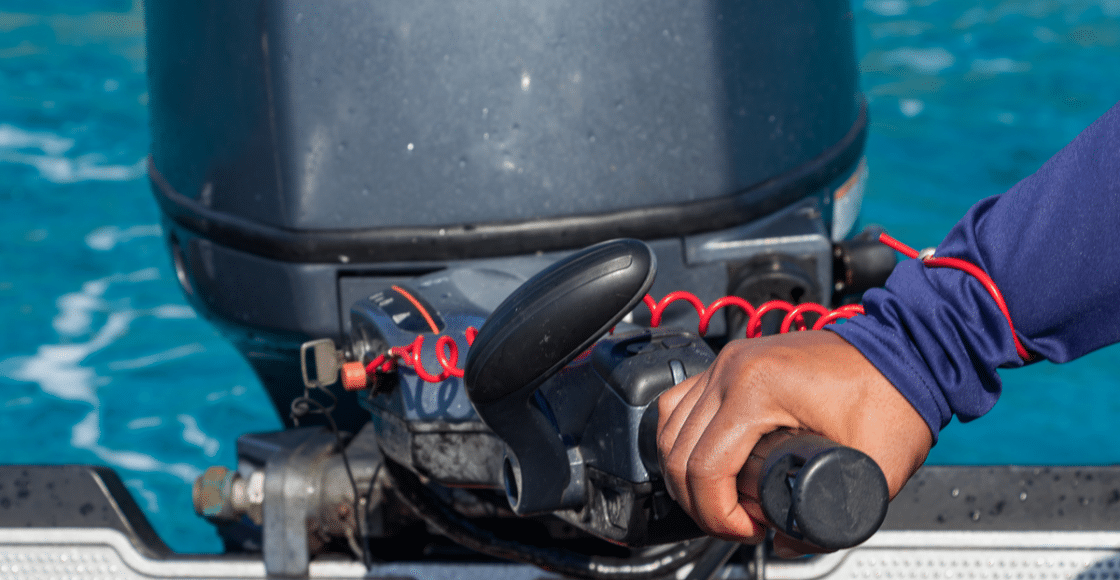
What is a Tiller on a Boat?

Table of Contents
Last Updated on February 24, 2022 by Boatsetter Team
A tiller is a lever that is attached to the rudder and is used to turn a boat. Tillers are used on power and sailboats, and a tiller and rudder combination is the simplest way to steer a boat.
Or, the steering system can be very complex, with multiple rudders and steering components that must be aligned to work correctly. These more complicated steering systems can be attached to a tiller or wheel. Even with multiple rudders, some boats use tillers, some don’t, and a select few offer both.
Using a tiller is backward from using a steering wheel and takes a bit of getting used to. The steering wheel is turned in the direction you want to go. However, you push a tiller the opposite of the direction you want to take.
Whether sailing an eight-foot pram or an eighty-foot schooner, your boat will have a rudder. The difference between the two is how they turn that rudder. The pram will use a tiller. The schooner, however, will likely use a very large wheel to set its course.
What is the difference between a rudder and a tiller?
The rudder of a boat protrudes into the water from where it hangs on the transom , or it can be placed under a boat. On the other hand, the tiller is the lever one moves from side to side, making the rudder turn.
A rudder is a blade in the vertical position, and it acts as a foil. Rudders can be constructed from wood, fiberglass, aluminum, or carbon fiber. As water passes over the rudder, its position determines the course of the boat. The tiller is a lever that you use to turn the rudder to steer a boat.
On many power and sailboats, the rudder(s) are out of sight beneath the hull . For this type of design, the tiller is fitted to a post. The post is attached to the rudder, and it is fitted under the boat.
When steering with a tiller, it is moved opposite of the direction you want to go. It doesn’t take long to grow accustomed to using a tiller, and you have already used one if you have ever used an outboard motor that is so equipped.
Where is a tiller on a boat?
It can be to the rear of the boat (astern), or it can be forward of that location and be fitted to a pipe that comes through the boat’s decking. Wherever it is located, its length and fittings (cleats, lines, and self-steering system attachments) are different from boat to boat.
What remains the same is that the tiller is what you use to steer the boat when so equipped. Tillers are often seen on boats less than 30 feet in length and predominately on sailboats. However, even some powerboats use a tiller for steering, and they are still used on many fishing and pleasure boats.
A tiller is chosen over a wheel for steering a boat because it is simpler and easier to repair if it breaks. In addition, the components of a steering system add weight to a boat and can be complicated.
A few newer style boats, such as sailing and ocean kayaks, use foot pedals attached to pulleys that lead to the rudder and move it side to side. This type of system works well on some boats but not on others.
Small outboard motors have a tiller.
Small outboard motors have a tiller attached to them to turn the motor and control the engine’s speed. These are usually seen on outboard motors that are 15 horsepower and below. However, they even offer tiller extensions for use on some boats.
Although they lack a rudder, the principle is the same, and the motor’s thrust takes its place. Outboard tillers house the throttle on many models, and others offer more features than a throttle alone.
A boat’s steering system
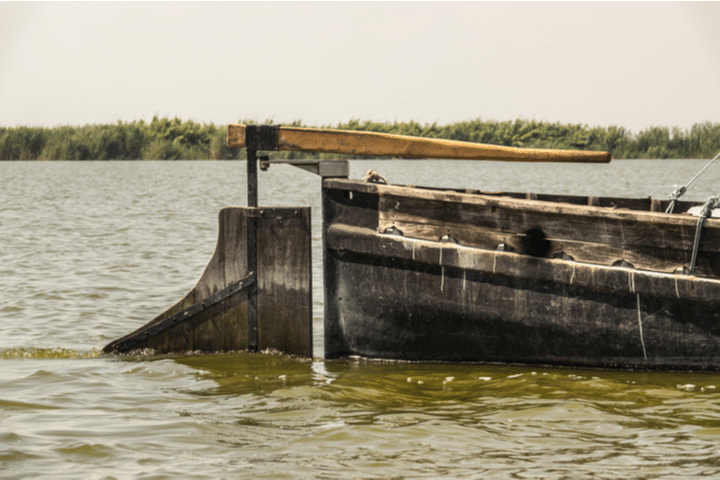
The most rudimentary steering system for a boat is a paddle. When wielded by someone with skill, paddling is very effective. Next up are oars for propulsion and steering, and again, a person skilled with oars can spin a boat within its own length.
On up the evolutionary trend of boat design came the long oar, strapped to the stern of large craft and used to steer. That was an unwieldy arrangement, and the designers forged on until they came upon rudder after decades of messing about with paddles as rudders.
The affixed rudder and tiller combination came on the scene around the 1st century. Voila, the tiller, was born and was the primary method of steering a boat until someone developed a pulley system attached to the rudder with rope or steel cable.
Even today, with modern wheel steering systems, some world sailors prefer the simplicity of a tiller, even on large sailing vessels. It is more straightforward, not as prone to problems, and is relatively easy to repair. Tillers can be made of wood, aluminum, carbon fiber, or almost any other stiff, durable material. You can fit a tiller with extensions, tiller pins, and attachments for self-steering systems.
What is a tiller pin used for?
Tiller pins are metal pins that allow one to detach the tiller from the head of the rudder very easily. A tiller pin also allows the tiller to hinge upward. This will enable you to store it out of the way when a boat is moored.
Other than sailboats, and some powerboats, tillers are used on narrowboats. A narrowboat is a canal boat that is used predominately in Europe. Most of them use rudders with which to steer, to which a tiller or tiller bar is attached.
The tiller pin on a narrowboat is often a decorative metal piece with a specific purpose. It performs the same task as it does on dinghies and creates a hinge point that allows the tiller to be bent back 180 degrees so that it is out of the way of the cockpit when moored.
What is a Norwegian tiller?
The Norwegian tiller is but another idea that facilitates steering a sailboat. Due to the design of a boat, tillers have been crafted to overcome fitment on double-ended sailboats and on boats whose rigging lies in the path of where a tiller generally resides.
Thus, the Norwegian tiller is placed at a right angle to the rudder instead of aligning with it. The tiller is then fitted with a stick with which you push or pull the tiller to steer.
Methods of steering a boat have evolved; however, some of the old ways of doing things have been proven to work well. For example, rudders and tillers may be more high-tech than 50 years ago, but they still serve the same purpose; they are used to steer a boat.
Learning the Ropes of Boating
Whether you’re a novice boater or have been around them for decades, boat designs are continually evolving, and the evolution makes them more costly. So let’s face it, boating is expensive, and the best way to learn if you like to sail, fish, or even go boating is to get on the water.
At Boatsetter, a local fleet of boats awaits your adventures. The fleet is comprised of sailboats, fishing boats, ski boats, yachts, and houseboats . They offer you endless opportunities to find what boating niche suits your fancy. So, no matter where you live, finding a boat to sail, or one with which to chase a prized bass, there’s likely a Boatsetter boat near you.

Boatsetter empowers people to explore with confidence by showing them a world of possibility on the water. Rent a boat, list your boat, or become a Boatsetter captain today.
Browse by experience

Explore articles

Peanut Island Boating Guide
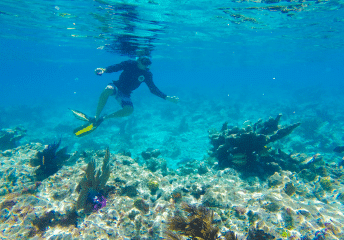
Snorkeling in Naples, FL

Cruise Banderas Bay with Boatsetter

Florida Social Distancing Activities for Spring Break 2021
- Types of Sailboats
- Parts of a Sailboat
- Cruising Boats
- Small Sailboats
- Design Basics
- Sailboats under 30'
- Sailboats 30'-35
- Sailboats 35'-40'
- Sailboats 40'-45'
- Sailboats 45'-50'
- Sailboats 50'-55'
- Sailboats over 55'
- Masts & Spars
- Knots, Bends & Hitches
- The 12v Energy Equation
- Electronics & Instrumentation
- Build Your Own Boat
- Buying a Used Boat
- Choosing Accessories
- Living on a Boat
- Cruising Offshore
- Sailing in the Caribbean
- Anchoring Skills
- Sailing Authors & Their Writings
- Mary's Journal
- Nautical Terms
- Cruising Sailboats for Sale
- List your Boat for Sale Here!
- Used Sailing Equipment for Sale
- Sell Your Unwanted Gear
- Sailing eBooks: Download them here!
- Your Sailboats
- Your Sailing Stories
- Your Fishing Stories
- Advertising
- What's New?
- Chartering a Sailboat
- Sailboat Tillers
Sailboat Tillers versus Wheel Steering
I'm a big fan of sailboat tillers and I have a question:
"Just who told the marketing men that we all want to steer our boats with wheels?"
Admittedly, centre cockpit designs have to be wheel steered owing to the distance between the helming position and the rudder. And so do large heavy displacement designs where the tiller would need to be inconveniently long.
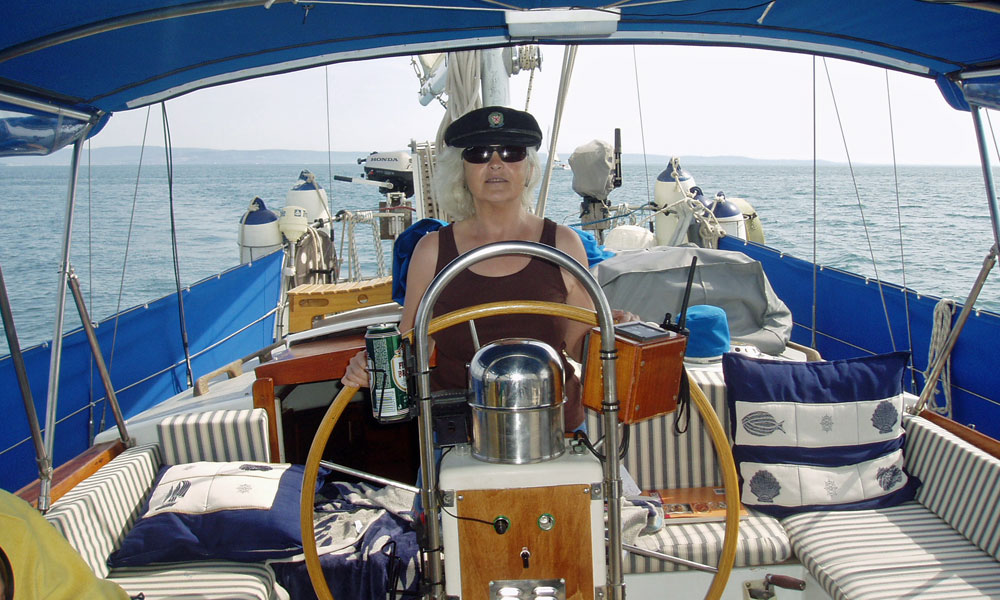
But for most moderate-displacement, aft-cockpit designs under 45 feet (14m) or so a sailboat tiller often makes more sense, and is much more fun to use.
Nothing beats sitting out on the coaming with a tiller extension helming the boat like a large dinghy. Well, for a while anyway - gone are the days when I'd do this for hour after hour!
When we built Alacazam , a boat which responds enthusiastically to this kind of involvement, we positioned the primary and secondary winches a bum-width apart for this very purpose.
Strangely, over the years, these winches have got closer together...
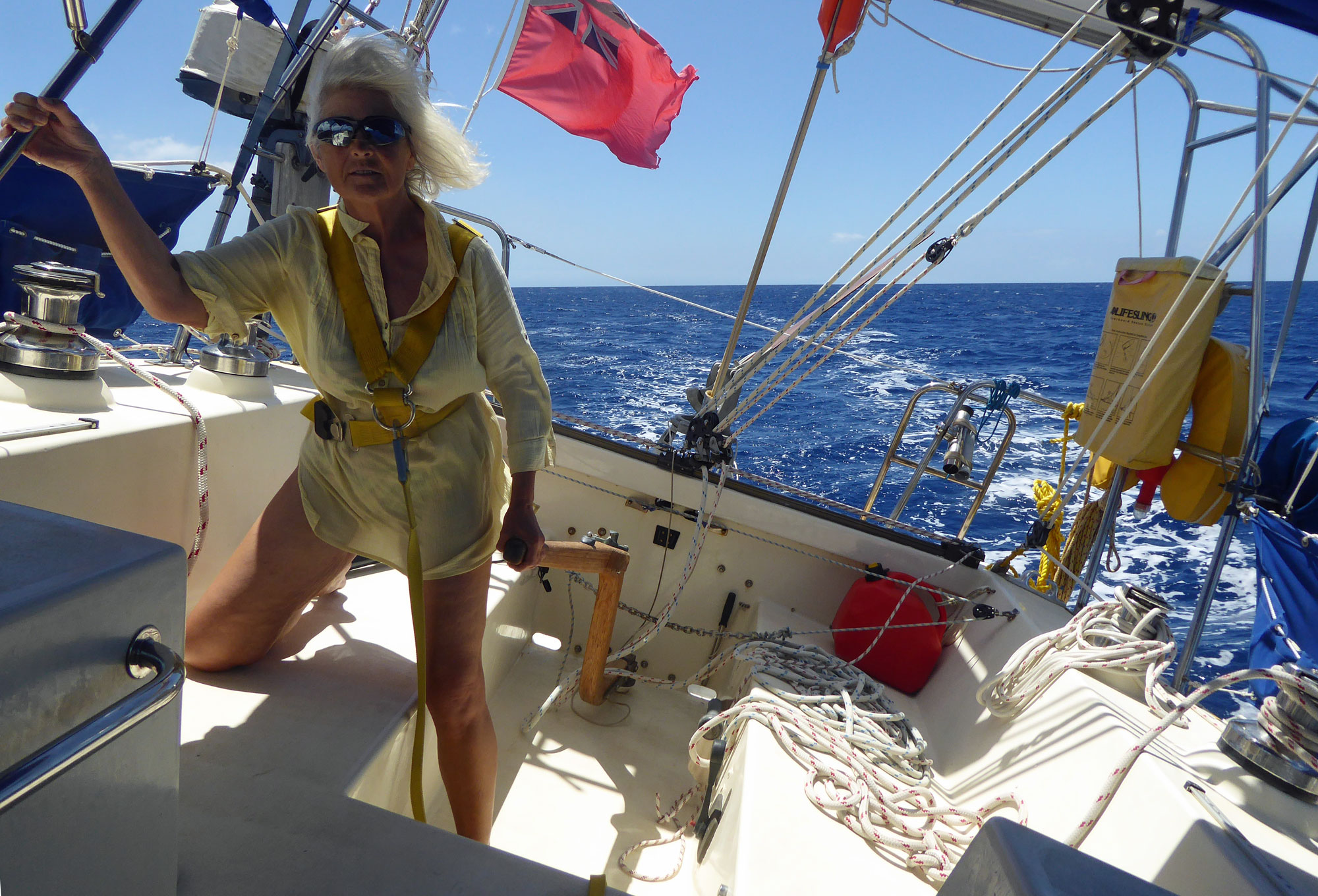
Twin Wheels, anyone?
I could almost understand a case for twin wheels if it offered redundancy in the event of linkage failure, but in most cases it doesn't. Both wheels usually share the same linkage; so if it fails, they both fail.
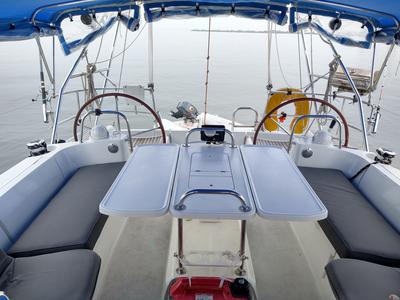
I can understand the need for twin wheels on a wide-sterned racing yacht, but in a more conventionally proportioned cruising boat, to me, it doesn't make a lot of sense. It can only be a fashion thing...
Comparison of Sailboat Tillers and Wheels
So having confessed my preference for tiller steering, perhaps I should explain myself...
A tiller...
- takes up less space in the cockpit than a wheel;
- through its direct attachment to the rudder, rewards the helmsman with ultimate feel and feedback;
- by virtue of its mechanical simplicity ensures reliability and robustness;
- allows the helmsman, steering with the tiller between his legs, trim the jib, mainsheet and - if he's really brave - the spinnaker , without disturbing the offwatch crew;
- works well with both windvane servo-pendulum self-steering gears and electronic autopilots;
- allows the helmsman to gain shelter from the sprayhood;
- at anchor can be lifted up out of the way, leaving the cockpit clear;
- It can't be geared down to make high steering loads manageable;
- and it can be tiring to hold for long periods of time, especially in strong winds or rough seas. You may need to use an extension handle, an autopilot, or a self-steering system to reduce fatigue;
- and it can limit your visibility of the sails, the instruments, or the horizon, depending on where you sit in relation to the tiller. You may need to move around frequently or rely on other crew members to check these aspects;
- and a tiller can be awkward to use in tight spaces, such as marinas or docks, where you may need to make quick and precise maneuvers. You may need to practice reversing or turning with a tiller before attempting these situations.
Whereas a wheel...
- can be geared down to make high steering loads manageable;
- positions the helmsman right aft, denying him any protection from the sprayhood;
- in most cases, doesn't allow the helmsman to trim the sails on his own;
- is less precise than a tiller, offers the helmsman little feedback;
- requires an expensive and complicated linkage arrangement of wires and blocks which, without regular maintenance, is prone to failure;
- is awkward to link to both windvane self-steering gears and electronic autopilots, and
- adds weight right aft, just where you need it least;
- clutters up the cockpit when at anchor;
- is more complex and expensive to install and maintain than a tiller, which may require cables, pulleys, gears, or hydraulics;
- a wheel does allow you to sit or stand in different positions in the cockpit, which can improve your visibility of the sails, the instruments, or the horizon.
A convincing case for a tiller? Well, that's really for you to decide, but pointedly, all wheel steered boats have - or should have - an emergency tiller, which may tell us something.
Fashion has a lot to answer for!
Tiller vs Wheel Steering: A Few FAQs...
How do you set up self-steering with a sheet-to-tiller system on a sailboat?
A sheet-to-tiller system is a way of using the jib sheet and some bungee cords or surgical tubing to steer the boat without holding the tiller. The basic principle is that when the boat veers off course, the jib sheet will pull or slacken the tiller, which will correct the course. To set up this system, you need to do the following steps:
- Trim the jib sheet through its usual leeward block, then run it to a block on the windward side of the cockpit beside the tiller;
- Attach one end of a bungee cord or surgical tubing to the leeward side of the cockpit near the stern, then run it through another block near the end of the tiller and back to itself. This will create tension on the leeward side of the tiller;
- Tie one end of a short cord (about 9 or 10 feet) to the jib sheet near where it exits from its leeward block, then run it through another block near where it enters its windward block. Tie the other end of this cord to an eyelet or cleat on top of the tiller. This will create tension on the windward side of the tiller;
- Adjust the tension of both sides of the tiller until they are balanced and keep the boat on course. You may need to experiment with different lengths and elasticities of bungee cords or surgical tubing until you find what works best for your boat.
How do you lock the tiller on a sailboat?
Locking the tiller on a sailboat can be useful when you need to leave the helm for a short time, such as adjusting the sails, checking the charts, or using the head. There are different ways to lock the tiller, depending on your boat and equipment. Some common methods are:
- Using a tiller lock or clamp that attaches to the tiller and the cockpit sole or coaming. This will hold the tiller in place and prevent it from moving. You can adjust the tension of the lock or clamp to allow some play or movement of the tiller if needed;
- Using a tiller tamer or brake that attaches to the tiller and a line that runs through two blocks on either side of the cockpit. This will create friction on the tiller and slow down its movement. You can adjust the tension of the line to control how much resistance the tiller has;
- Using a bungee cord or surgical tubing that attaches to the tiller and two points on either side of the cockpit, such as cleats, stanchions, or lifelines. This will create tension on the tiller and keep it centred. You can adjust the length and elasticity of the bungee cord or surgical tubing to allow some movement of the tiller if needed.
How do you set up an autopilot with a wheel steering system on a sailboat?
An autopilot is a device that can steer the boat without human intervention, based on a pre-set course or data from sensors. To set up an autopilot with a wheel steering system on a sailboat, you need to do the following steps:
- Choose an autopilot that is compatible with your boat size, type, and steering system. There are different types of autopilots, such as cockpit-mounted, below-deck-mounted, hydraulic, electric, or wind-powered;
- Install the autopilot components, such as the control unit, display unit, drive unit, compass sensor, wind sensor, speed sensor, and GPS receiver. Follow the manufacturer's instructions and wiring diagrams carefully;
- Calibrate and test the autopilot for accuracy and performance. You may need to adjust some settings, such as rudder gain, counter rudder, response level, and off-course alarm.
The above answers were drafted by sailboat-cruising.com using GPT-4 (OpenAI’s large-scale language-generation model) as a research assistant to develop source material; to the best of our knowledge, we believe them to be accurate.
Recent Articles
Ovni 445 Sailboat Specs & Key Performance Indicators
Aug 29, 24 03:44 AM
Catalina 34 Sailboat Specs & Key Performance Indicators
Aug 29, 24 12:14 AM
Westerly Discus 33 Sailboat Specs & Key Performance Indicators
Aug 28, 24 02:14 AM
Here's where to:
- Find Used Sailboats for Sale...
- Find Used Sailing Gear for Sale...
- List your Sailboat for Sale...
- List your Used Sailing Gear...
Our eBooks...

A few of our Most Popular Pages...

Copyright © 2024 Dick McClary Sailboat-Cruising.com

- Information
- Call Us: 0203 006 3717 (9:30am-4:30pm)
Choosing Your Helm: Tiller vs. Steering Wheel on a Sailing Yacht
Are you considering setting sail but unsure whether to opt for a tiller vs. steering wheel on a sailing yacht? At First Class Sailing, we offer both unique experiences, each with its own set of advantages. Let’s navigate through the differences between these two steering mechanisms and explore the pros of each to help you make an informed decision for your next sailing trip.
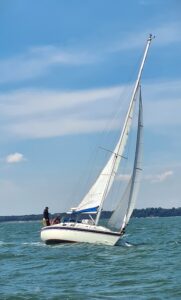
Tiller vs. Steering Wheel – Understanding the Basics
Before we delve into the pros of each, let’s clarify the fundamental distinctions between a tiller and a steering wheel:
Tiller: A tiller is a simple lever mostly used for steering smaller sailboats. It’s typically a horizontal bar attached directly to the boat’s rudder. When you push the tiller to port (the left side of the boat as you look forward), the boat turns to starboard, and vice versa. Tiller steering provides direct control and feedback from the water, making it a popular choice for smaller vessels and traditional sailing purists.
Steering Wheel: A steering wheel, on the other hand, is a familiar sight on larger sailing yachts and powerboats. It operates through a system of pulleys, cables, and a quadrant attached to the rudder. Unlike the direct connection of a tiller, a steering wheel offers mechanical advantage, allowing for smoother and more effortless steering, particularly in challenging conditions or when navigating over longer distances.
The Pros of a Tiller
Direct Sensation: One of the significant advantages of a tiller is the direct feedback it provides. You feel the nuances of the water and wind through the tiller, fostering a deeper connection between you, the boat, and the elements.
Simplicity: Tiller steering is straightforward and requires minimal maintenance. With fewer mechanical components, there’s less chance of failure, making it a reliable choice for smaller vessels and beginners.
Manoeuvrability: Tiller-steered boats are often more manoeuvrable, especially in tight spaces or when making precise course adjustments. The simplicity of the tiller allows for quick responses to changing wind and water conditions.
Cost-Effectiveness: In terms of both initial investment and ongoing maintenance, tiller systems are generally more affordable than their wheel-steered counterparts. This makes them an attractive option for budget-conscious sailors or those who prefer simplicity.
The Pros of a Steering Wheel
Comfort and Ergonomics: Steering wheels offer a comfortable and ergonomic steering experience, particularly on larger vessels. The wheel’s size and positioning allow for easy handling over extended periods, reducing fatigue on longer voyages.
Control in Challenging Conditions: In rough seas or high winds, a steering wheel provides better leverage and control compared to a tiller. The mechanical advantage afforded by the wheel’s design makes it easier to maintain course and stability, enhancing safety and confidence for both experienced and novice sailors.
Accessibility: For sailors with limited physical strength or mobility, a steering wheel can be easier to operate than a tiller, especially on larger boats where tiller forces may be greater. This accessibility factor broadens the appeal of sailing to a wider range of enthusiasts.
Instrument Integration: Steering wheel pedestals often feature space for instrument displays, such as GPS navigation systems, radar screens, and autopilot controls. This integration allows for convenient access to vital information while steering, enhancing situational awareness and navigation efficiency.

Tiller vs. Steering Wheel – Setting Your Course
Whether you opt for the direct connection of a tiller or the mechanical advantage of a steering wheel, both steering mechanisms offer distinct advantages tailored to different sailing preferences and conditions. Ultimately, the choice between a tiller and a steering wheel comes down to personal preference, boat size, intended use, and sailing style.
At First Class Sailing, we understand the importance of selecting the right equipment for your sailing adventures, whichever helm you choose – tiller vs. steering wheel. Our Fulmar 32, christened Leo in our fleet is the smallest in size, but her capabilities extend far beyond her dimensions. Purposefully designed, she serves as an ideal vessel for couples seeking a more personal environment to undertake RYA courses.
Leo is perfectly suited for our RYA Competent Crew or RYA Day Skipper Practical courses. You can book the whole boat with your friend or partner, and do either, or both courses at the same time if you’re at different levels from one another.
Fair winds and following seas!
Posted by: First Class Sailing
Post a Comment Cancel reply
Name (required):
Email (required):
Your comment (required):
- All Categories
- Antigua – Portsmouth
- Atlantic Adventures
- Boat Handling Master Classes
- Channel Crossing – Channel Islands
- Coastguard Closures
- Crowdfunding
- Experiences and Challenges
- Fastnet Race
- Global Ocean Race
- Golden Vanity
- Learn to Sail
- Night Sailing
- Norway Challenger
- OnLine Learning
- Passage Planning
- Portsmouth – Gran Canaria
- Round the Island Race
- RYA Competent Crew
- RYA Courses
- RYA Day Skipper
- RYA Diesel Engine Maintenance Course
- RYA VHF Radio Course
- RYA Yachtmaster
- Sail Round Britain
- Sailing Around Britain
- Sailing Events
- Sailing Holidays
- Sailing in media
- Sailing in the West Country
- Sailing Tales
- Sailing Trips
- Skippered Charter
- Southampton Sailing Week
- Traditional Sailing
- UK Sailing Holildays
- Whole Boat Charter
- Yacht Design
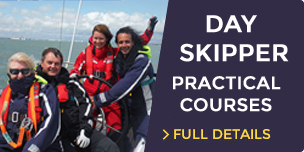
Sorry. No data so far.

We love to hear from our customers and we are happy to call/email you to discuss your sailing needs.
Tiller for Sailboat: A Comprehensive Guide
by Emma Sullivan | Jul 21, 2023 | Sailboat Maintenance

==Short answer: Tiller for sailboat== A tiller is a lever used to steer a sailboat. It connects directly to the rudder, allowing the sailor to control the direction of the boat. The tiller is typically made of wood or metal and is positioned at the aft of the vessel for easy access and maneuverability.
Choosing the Right Tiller for Your Sailboat: A Comprehensive Guide
Introduction:
Sailing is an art that requires a combination of skill, intuition, and the right equipment. When it comes to controlling your sailboat, one crucial component that deserves your attention is the tiller. The tiller acts as the steering mechanism, allowing you to navigate through the waters smoothly and efficiently. However, choosing the right tiller for your sailboat can be a daunting task, given numerous options available in the market. But fear not! In this comprehensive guide, we will walk you through everything you need to know about selecting the perfect tiller for your beloved vessel.
Understanding Tiller Basics:
Before delving into different types of tillers available, let’s start by understanding some fundamental concepts regarding their design and functionality. The tiller serves as a lever that connects directly to a boat’s rudder or yoke. It provides sailors with precise control over their vessel’s direction by simply moving it left or right. Tillers are typically made from sturdy materials like wood, stainless steel, or carbon fiber for optimum durability while ensuring ease of use.
Different Types of Tiller Materials:
Wood: Tradition meets elegance with wooden tillers! Wood offers timeless beauty while providing excellent grip and sturdiness. Many sailors choose wooden tillers due to their aesthetic appeal and simplicity in maintenance. However, keep in mind that wooden tillers might require periodic coating with varnish or other protective solutions to withstand constant exposure to water.
Stainless Steel: If you’re seeking durability and corrosion resistance packed with modern aesthetics, stainless steel tillers should be on top of your list. Stainless steel allows for a sleek appearance while ensuring longevity even under harsh weather conditions. Moreover, its smooth surface reduces friction between hands and the tiller shaft, making maneuvering effortless.
Carbon Fiber: For those seeking cutting-edge technology coupled with lightweight strength, carbon fiber stands out as the ultimate choice. Carbon fiber tillers offer exceptional stiffness, reducing any unnecessary bending or flexing while sailing. With its high resistance to corrosion and impressive performance, carbon fiber tillers have become increasingly popular among avid sailors.
Choosing the Right Size:
When it comes to selecting the appropriate size for your tiller, it should fit comfortably in your hands without causing strain or discomfort during extended periods at sea. The length of a tiller is also crucial as it determines how far you need to reach from your seated position to effectively steer the vessel. Generally, tillers range from 3 to 6 feet in length, with longer options providing more leverage but potentially causing interference with cockpit space.
Considerations for Your Sailboat Type:
Different sailboat designs may require specific considerations when choosing a tiller:
– Monohulls: For monohull sailboats, it’s essential to consider factors such as rudder placement and cockpit configuration. Depending on whether you have an aft-mounted or transom-hung rudder, you may need a shorter or longer tiller respectively. – Catamarans: The wide beam characteristic of catamaran hulls demands careful consideration when selecting a tiller. The size and shape should allow for easy passage between hulls while maintaining optimal control over each rudder. – Dinghies: Dinghies often necessitate lightweight materials and compact designs for enhanced maneuverability in tight spaces. Here, carbon fiber or aluminum alloy tillers are excellent choices due to their strength-to-weight ratio.
Conclusion:
Choosing the right tiller for your sailboat can significantly impact your overall sailing experience. By considering various factors like material, size, boat type compatibility, and personal preferences – be they traditional elegance or cutting-edge technology – you can find the perfect match that complements both form and function aboard your vessel. So cast off those doubts and set course confidently with a reliable companion steering you towards new nautical adventures!
How to Use a Tiller for Your Sailboat: Step-by-Step Instructions for Novices
If you’re a novice sailboat enthusiast, the concept of using a tiller may initially seem daunting. However, fear not! We are here to guide you through the process step-by-step and help you become the sailor you’ve always dreamt of being. So grab your captain’s hat and let’s dive right in!
What is a tiller, you may ask? A tiller is essentially a lever attached to the rudder of your sailboat that allows you to control its direction. Think of it as the steering wheel of the sea, putting you in complete command.
Step 1: Get Acquainted with Your Tiller Before setting sail, it’s crucial to take some time getting familiar with your trusty tiller. Locate it near the stern (rear) of your boat – it’s usually a wooden stick or metal rod extending outward from the transom.
Step 2: Determine Your Leeward Side Now that you’ve established where your tiller lives, let’s explore which side of your boat is leeward. Picture yourself standing at the back-facing forward; leeward refers to the side opposite to where the wind comes from. Got it? Excellent!
Step 3: Position Yourself Correctly To successfully manipulate your tiller, stand or sit on whichever side aligns with the leeward location we discussed earlier. This helps maintain balance and ensures proper control over your vessel throughout each glorious voyage.
Step 4: Grasp Control With confidence brimming within you, grab onto that trusty tiller firmly but without exerting excessive force. Remember, finesse is key here – finesse like a skilled musician delicately playing their instrument.
Step 5: Feel It Out As soon as you’re at ease holding onto your tiller, close your eyes for just a moment (please don’t do this while sailing!). Take notice of how subtle movements can translate into significant adjustments in your sailboat’s heading. It’s like an eloquent dance between you, the tiller, and the sea.
Step 6: Turning Left or Right When it’s time to make a turn, prepare for an exhilarating experience! To go left, push the tiller away from yourself using your right hand. Conversely, to turn right, do precisely the opposite – pull the tiller towards you with your left hand. Pretty intuitive once you get the hang of it!
Step 7: Navigating Straight Ahead Occasionally, you may desire to continue sailing blissfully straight ahead without any fancy maneuvers. To do this, simply maintain a centered position with your hands on the tiller and ensure both hands apply equal pressure. This technique guarantees a steady course through tranquil waters.
Step 8: Advanced Tiller Techniques Once you’ve mastered these fundamentals, congratulations – you’re officially poised to explore more advanced tiller techniques! These can include tacking (changing direction while crossing wind), jibing (changing direction when wind comes from behind), and executing quick maneuvers that will impress even seasoned sailors.
There you have it – step-by-step instructions on how to use a tiller for your sailboat as a novice sailor. Remember, patience and practice are essential keys to becoming a maestro of manoeuvers. So go out there and embrace the freedom of the open sea with confidence in every swing of your trusted tiller. Bon voyage!
Frequently Asked Questions about Tiller Systems for Sailboats
Frequently Asked Questions about Tiller Systems for Sailboats: Demystifying the Steering Mechanism
Ah, the tiller – that humble yet critical component of any sailboat’s steering system. Whether you’re a seasoned sailor or just getting started, understanding how tiller systems work and their benefits can enhance your sailing experience. To shed light on this frequently misunderstood subject, we’ve compiled a list of questions often asked about tiller systems for sailboats.
1. What is a tiller system, and how does it work?
A tiller system is the method by which sailors control the direction of their boats. It consists of a long wooden or metal bar connected to the rudder at one end and operated by hand at the other end. When a sailor turns the tiller in either direction, it moves the rudder accordingly, causing the boat to change course.
2. Why are tillers used instead of traditional steering wheels?
Tillers have been used for centuries due to their simplicity and efficiency. Unlike steering wheels commonly seen on motorized vessels, tillers offer direct feedback and precise control over the boat’s movement with minimal mechanical components. They also provide an immersive experience by physically connecting sailors with their vessel.
3. What are some advantages of using a tiller system?
Tiller systems provide several notable advantages over alternative steering mechanisms:
a) Responsiveness: Tiller-operated boats respond rapidly to even slight adjustments in helm input. This responsiveness allows for quick maneuvering in tight spaces or adverse weather conditions.
b) Sensitivity: With a direct connection between hand and rudder, sailors can feel subtle changes in water conditions through the tiller’s vibrations before they visually manifest in boat movement.
c) Reliability: Due to their simple construction, tillers have minimal parts that could potentially fail or require maintenance compared to complex wheel steering mechanisms.
4. Do all sailboats use tillers?
While many smaller boats, such as dinghies and single-handed sailboats, primarily use tillers, larger vessels often feature wheel steering systems. The choice between tiller and wheel primarily depends on the size and design of the sailboat, as well as personal preference.
5. Can a tiller system be retrofitted onto a boat with a wheel?
Yes! While more involved than simply attaching a tiller to an existing rudder, it is possible to convert a boat from a wheel system to a tiller system. This process typically involves modifications to the rudder post and cockpit layout, making it advisable to consult with a knowledgeable marine professional for guidance.
6. Are there any downsides to using a tiller system?
Though rare, certain drawbacks exist within tiller systems:
a) Space limitation: Tiller systems require ample space in the cockpit for maneuvering since the helmsperson stands or sits near the stern rather than at the bow.
b) Physical effort: Steering larger boats with tillers can require more physical exertion compared to finger-tip-controlled wheel steering systems due to increased leverage required.
7. How can I improve my skills in operating a sailboat equipped with a tiller system?
Practice makes perfect! Spending time on the water honing your skills will enhance your ability to steer precisely and react effectively under various sailing conditions. Consider taking sailing courses or participating in regattas where experienced sailors can offer tips specific to tiller-operated vessels.
So there you have it – your burning questions about tiller systems for sailboats answered in one fell swoop! Understanding how this integral part of sailing works allows you to navigate not only your ship but also the vast ocean of knowledge surrounding these unique steering mechanisms.
Finding the Perfect Tiller Extension for Your Sailboat
Are you a seasoned sailor or a beginner taking your first steps into the world of sailing? Whichever category you fall into, one thing is for certain – having the right equipment is essential to make your experience on the water enjoyable and hassle-free. And when it comes to sailboats, finding the perfect tiller extension can make all the difference in how smoothly you handle your vessel.
A tiller extension is a fantastic tool that allows sailors to effectively control their boat by extending their reach. It acts as an extra arm, giving you better leverage and control over your sailboat’s rudder without having to strain your body or be confined to a single position. This means more comfort, less fatigue, and ultimately more enjoyment while sailing.
But with so many options available in the market today, finding the perfect tiller extension can seem like searching for a needle in a haystack. Don’t fret! We’ve put together this comprehensive guide to help you find that ideal extension tailored specifically to your needs.
Firstly, it’s important to consider the material of the tiller extension. While many extensions are made from aluminum or fiberglass, high-quality carbon fiber extensions have gained popularity due to their incredible strength-to-weight ratio. Carbon fiber provides excellent durability without weighing down your boat or compromising on performance.
Next up is length. Determining the right length for your tiller extension depends on various factors such as boat size, sailing conditions, and personal preference. As a general rule of thumb, shorter extensions are ideal for smaller boats or when sailing alone since they provide better maneuverability in tight spaces. On the other hand, longer extensions are advantageous when sailing with multiple crew members or on larger vessels where reaching across wider cockpits becomes necessary.
Grip style is another crucial aspect worth considering. The grip design should offer enough comfort and control for extended periods spent navigating through waves and changing winds. Look for ergonomic grips that are slip-resistant, allowing you to maintain a solid hold even when things get bumpy out on the water.
When it comes to features, there are a few innovative options that can greatly enhance your sailing experience. Some tiller extensions come with telescopic capabilities, enabling easy adjustment of length to suit various scenarios. Additionally, consider extensions with quick-release mechanisms that allow for swift detachment during emergencies or when docking your boat. These convenient features can be game-changers that make your time on the water more efficient and safe.
Lastly, price may be a determining factor in your decision-making process. While it’s always tempting to opt for budget-friendly options, remember that investing in a durable and reliable tiller extension is an investment in your comfort and safety while sailing. Spending a little extra now will ultimately save you from potential headaches down the line.
So, whether you’re an experienced sailor looking to upgrade or a newcomer searching for the perfect tiller extension for your sailboat, keeping these factors in mind will steer you towards making the right choice. Remember – finding the perfect tiller extension adds convenience and control to your sailing adventures, allowing you to navigate the waters with finesse and enjoyment. Happy sailing!
Upgrading Your Sailboat’s Tiller: Tips and Tricks
Ahoy, fellow sailors! If you’re looking to take your sailing experience to the next level, upgrading your sailboat’s tiller is an excellent place to start. Not only can a new tiller enhance the performance of your vessel, but it can also add a touch of style and sophistication to your sailing adventures. So, grab a drink, sit back, and let’s dive into some professional yet witty tips and tricks for upgrading that trusty tiller of yours.
First things first – why should you even consider upgrading your sailboat’s tiller? Well, my friends, the tiller is arguably one of the most critical components when it comes to steering your boat. A sturdy, well-designed tiller allows for better control and maneuverability on the water. Additionally, a new tiller can provide increased comfort during long hours at sea by minimizing hand fatigue and providing better grip.
When choosing a new tiller for your sailboat, you’ll want to take a few factors into consideration. The material of the tiller plays a crucial role in its durability and overall performance. While traditional wooden tillers exude charm and elegance, they tend to require more maintenance. On the other hand, carbon fiber or fiberglass composite options offer superior strength while being lightweight and low-maintenance.
Now comes the fun part – selecting a visually appealing tiller that suits both your aesthetic preferences and practical needs. Consider opting for a sleek design with ergonomic features that fit comfortably in your hand. Some modern tilers even come equipped with innovative features such as built-in compasses or smartphone holders – perfect for those who like their gadgets while navigating the high seas!
When it comes to installation, it’s essential to ensure that the new tiller fits properly into your sailboat’s helm assembly. In most cases, this involves measuring carefully and potentially making adjustments or modifications if necessary. If you’re not confident in your DIY skills, don’t hesitate to seek the help of a professional. After all, a proper installation guarantees safe and efficient sailing.
Now, let’s address the inevitable question of budget. Upgrading your sailboat’s tiller can range from affordable to extravagant – it all depends on your personal preferences and financial capabilities as a savvy sailor. Keep an eye out for sales or discounts in boating stores, browse online marketplaces, or consider purchasing pre-owned tillers that are still in good condition. Remember: it’s not necessary to break the bank – upgrading your tiller can still be within reach even for those on a tighter budget.
Lastly, don’t forget about maintenance! To keep your newly upgraded tiller in ship-shape condition, regularly clean it with mild soap and water. Apply a protective coating if needed, especially for wooden tillers that are prone to weathering. Additionally, inspect and tighten all connections periodically to ensure everything remains secure during your sailing adventures.
So there you have it – a detailed professional and clever guide on upgrading your sailboat’s tiller. With these tips and tricks under your belt, you’ll be well on your way to enjoying enhanced control and style while navigating the open waters. Happy sailing!
Maintenance and Care of Your Sailboat’s Tiller: Expert Advice
Title: Mastering the Art of Tiller Maintenance and Care: Insights from the Sailing Pioneers
Introduction: Setting sail on a grand adventure upon your beloved sailboat wouldn’t be possible without the often-underappreciated tiller. This unsung hero connects you to the magic of wind and water, enabling you to navigate the vast sea with grace and precision. However, like any crucial component, proper maintenance and care are key to ensuring your tiller remains shipshape. In this blog post, we unveil expert advice on how to keep your sailboat’s tiller in pristine condition, enhancing both its longevity and your sailing experience.
1. Understanding Your Tiller’s Anatomy: Before delving into maintenance techniques, let’s explore the intricate design of your sailboat’s tiller – an ingenious marriage between functionality and beauty. Crafted from durable materials such as hardwood or fiberglass, these ergonomic extensions offer comfort while holding sway over your vessel’s direction. Familiarizing yourself with its composition is vital for future care.
2. Cleansing Rituals for Longevity: Imagine a tiller encrusted with salt residue or marred by sun-induced cracks; such experiences can certainly dampen any sailing excursion. To maintain its pristine appearance and extend its lifespan significantly, adopting regular cleaning rituals is paramount. Begin by rinsing off saltwater after every use using gentle freshwater streams to eradicate corrosive salts delicately trapped within crevices.
3. Condition Like a Pro: Just as our skin requires nourishment to remain supple, so too does your tiller require conditioning agents to withstand constant exposure to harsh elements. Opt for high-quality marine-grade oils that penetrate deep into the wood fibers or fiberglass surface – giving moisture-repellent protection against damaging UV rays and preventing wood rot in humid conditions.
4. The Unseen Enemy: Moisture Protection Strategies: Moisture is indeed the eternal nemesis of wooden components. Combat its destructive effects by introducing moisture barrier techniques. Applying a sealant or marine-grade varnish to the tiller’s surface provides an invisible shield against water penetration, preserving its structural integrity in the long run.
5. Love Your Tiller: Regular Inspections: Like any love affair, regular inspections are essential to maintaining a healthy and thriving relationship with your tiller. Pay close attention to signs of wear and tear, including cracks, splintering, or loose fittings. Promptly addressing these issues can prevent minor problems from escalating into major setbacks during your sailing sojourns.
6. Storage Savvy: When it’s time to bid adieu to the salty embrace of the sea, proper storage practices become paramount. Shield your tiller from excessive exposure to sunlight, which causes fading and brittleness over time – potentially resulting in catastrophic failures at crucial moments.
7. Craft Your Personalized Tiller Care Guide: Every sailboat is unique and requires tailored care schemes; similarly, your trusty tiller deserves an individualized maintenance plan crafted by you! Document a checklist encompassing regular cleaning rituals, conditioning treatments schedule, and inspection reminders – reassuring that you never miss a beat when tending to this unsung hero.
In Conclusion: By incorporating these expert tips into your routine sailboat maintenance regimen, you’ll ensure your tiller remains at the peak of its performance throughout endless nautical adventures. Remember, a well-maintained and cared-for tiller not only enhances safety but also keeps you connected to the soul-stirring wonders of sailing like nothing else can! So go forth confidently with this newfound wisdom and seize every glorious moment on the open seas!
Recent Posts

- Sailboat Gear and Equipment
- Sailboat Lifestyle
- Sailboat Maintenance
- Sailboat Racing
- Sailboat Tips and Tricks
- Sailboat Types
- Sailing Adventures
- Sailing Destinations
- Sailing Safety
- Sailing Techniques
- Boating Safety
- Company News
Experiences
- Destinations
- Boating Regulations
- Tillers on Boats
• 5 years, 8 months ago

Related Posts

What Does a Keel Do?

How Boat Steering Works

More Sailing Terms You Need to Know

Sailboat Types - Getmyboat Guide

Some boats use tiller steering while others use wheel steering. Both have advantages and disadvantages to be considered. Special techniques are used to steer tiller boats under sail. The type of steering on sailing vessels is mostly governed by boat length and weight. Many variables are considered when boats are designed, and the type of steering chosen on a particular boat provides the optimum control and convenience for the boat’s length and weight.
A Boat’s Tiller
A tiller is essentially a pole attached to the top of a rudder, It acts as a lever to directly pull or push the rudder. The rudder is a vertical, underwater blade positioned at the vessel’s stern, which can be moved to the left or right by the tiller. The rudder steers by redirecting water past the hull, creating turning motions for course changes. On most boats, rudders are positioned more or less perpendicular to the hull's longitudinal axis, which effectively brakes the vessel when pushed "hard over" by the tiller. The tiller and the rudder work together to steer by redirecting water past the hull, creating turning motions for course changes.
Beginning in the Middle Ages, tillers on larger ships were replaced by cables, ropes, or chains that connected a steering wheel to the rudder, allowing greater rudder control with far less effort. With the advent of steam engines, metal gears replaced cables and ropes. Today, some large ocean racing sailboats use tillers, which afford an unparalleled direct steering feel.
Pros and Cons of a Boat Tiller
A tiller’s simplicity, with no pulleys, chains, wires, gears, or hydraulics to complicate the steering system, makes it ideal for small sailboats. However, there are some downsides:
- Though simple to operate, tillers provide only a limited amount of leverage and mechanical advantage. Leverage and mechanical advantage amplify the helmsman’s use of strength and force, which makes sailing easier and far less tiring.
- On boats of any size, operating a tiller can be fatiguing, particularly in heavy seas. Without a steady grip on the tiller, it can jump out of the helmsman’s hand and deliver a painful blow to the gut or legs.
- An untended tiller can produce immediate — and usually radical — turning motions, causing a potentially unsafe situation for the crew and nearby vessels. An autopilot, lock, or shock cord will control tiller movement.
- Larger tiller boats are typically helmed while standing, which enhances visibility but creates the need to constantly balance the body. During long voyages this can be physically and mentally draining.
Advantages of a Boat’s Tiller
On the other hand, a tiller offers several advantages, including:
- Provides an almost immediate rudder response for safer and higher performance, particularly in close quarters.
- For experienced sailors (especially single-handed), a tiller allows multi-tasking while helming; the tiller can be moved with the legs, leaving the hands free to trim sails, eat, drink, etc.
- Many tillers fold out of the way when not needed, creating more cockpit space for easier access to winches, cleats, and other important parts of the boat.
- An experienced helmsman can feel if sails need trimming by the level of steering effort; also, water friction flowing around the rudder generates a feel used to make tiller adjustments.
- If desired, autopilots are generally less expensive and easier to install.
Tiller Towards Trouble
Steering with a tiller takes a lot of practice, especially because the tiller is moved in the direction opposite from the desired heading, exactly the reverse of steering wheel operation. The tiller is always moved in the direction opposite from which the bow is to move: if the tiller is moved to port (left) side, the bow turns to starboard (right); if positioned to starboard, the bow turns to port.
Tiller sailors are taught the saying tiller towards trouble, reminding them to push or pull the tiller towards (not away from) another boat, navigational aid, course mark, shore feature, or other potential danger that must be avoided. The saying (and its meaning) is counter-intuitive, but accounts for the fact that a tiller positioned in either direction except dead ahead will move the boat opposite the direction it is pushed.
For novice sailors, learning how to steer with a tiller can be a challenge. The best advice is to learn from an experienced helmsman in underway situations when tiller position and speed are critical, such as in heavy weather or when docking.
Close Quarters Maneuvering with a Tiller
The ancient technique of sculling is often used on tiller boats during close-quarters maneuvering, like docking. Sculling creates drag and turns the rudder into a “steering oar” of sorts, producing forward-thrust, side-to-side movements while changing the blade angle. Sculling takes practice to generate the desired amount of speed and direction, particularly near docks or mooring/anchoring points.
Tiller Extensions and Locks
A tiller extension, which is an adjustable sliding pole attached near the end of the tiller, makes it easier to move around the cockpit and generally allows easy access to control equipment. To hold the tiller in one position, sailors often use shock cord to pretension the tiller, which allows some flex in tiller movement and allows the boat to “find its own balance.”
Some sailors feel that a shiny, prominent steering wheel in the cockpit is much more nautical-looking than the tiller, but tillers do have their place, particularly on smaller sailing vessels. Sailing a tillered boat takes some practice to do so safely and efficiently, and boaters should always keep in mind, and practice, tiller towards trouble.
Browse Trip Categories
- About Getmyboat
- Media Inquiries
- Terms of Use
- Privacy Policy
- Cookies Policy
- Accessibility Statement
- Member Interface Agreement
- How It Works
- Mobile Apps
- Boat Rentals
- Jet Ski Rental
- Fishing Charters
- Houseboat Rental
- Pontoon Rental
- Yacht Rental
- Sailboat Rental
- Bachelorette Party Boat Rental
- Party Boat Rentals
- Experiences Guide
Popular Destinations
- Lake Travis
- Lake Lanier
- Newport Beach
- Lake Norman
24/7 live support
- Help & FAQs
- +1 818 927 2148
- [email protected]
Real reviews from happy Getmyboaters.
- AROUND THE SAILING WORLD
- BOAT OF THE YEAR
- Email Newsletters
- America’s Cup
- St. Petersburg
- Caribbean Championship
- Boating Safety
- Ultimate Boat Giveaway

Sailboat Racing Tips: Tiller Extension Technique
- By Mike Ingham
- May 31, 2022
- More: Sailing How To
- More How To

How To Refine Your Polars and Sail Charts

The Building Blocks of Asymmetric Spin Trim

Fundamental Tactics: How To Handoff

Racecourse Strategy: The Middle Versus the Edge

Mistakes And Misfires On the Final Day of Cup’s Preliminary Regatta

Emirates Team New Zealand Remain the Bullies of Barcelona

Start-Box Sparring in Barcelona on Day 2 of Preliminary Regatta

Real-time Wind Overlay Feature Added to Cup Broadcast

- Digital Edition
- Customer Service
- Privacy Policy
- Terms of Use
- Cruising World
- Sailing World
- Salt Water Sportsman
- Sport Fishing
- Wakeboarding

7 Best Sailboat Autopilot Systems

Last Updated by
Daniel Wade
June 15, 2022
Essential in increasing efficiency, safety, and convenience, marine autopilots are a sailor's best friend when out there on the water. A properly operating sailboat autopilot will keep your sailboat on a selected course even in strong currents and winds and that why you need to go for the best sailboat autopilot.
Steering a sailboat is always fun. And even though many sailors are so good at it, some circumstances can make steering a boat on a straight line or the right course almost impossible. The tides, winds, and the complex hull-bottom designs can throw your sailboat off route and the adjustments that you have to make to return to course can be your voyage killers. Even if you have a crew that regularly sails with you, having an autopilot can help you stay on course and that's exactly why you need the best sailboat autopilot.
In the simplest term possible, an autopilot is an extra pair of hands that can help you in steering your sailboat on the right course. It is a self-steering device for powerboats or sailboats and even the most basic autopilot can help in holding your vessel on a pre-set compass course. Some advanced autopilots can even gather data from your boat and determine whether or not the boat is capable of handling the task in hand.
So whether you have a mechanically-steered boat or a tiller-steered sailboat, an autopilot is of great importance for both you and your boat. And it doesn't matter whether you want to explore your nearest lake for a day or want to sail to the Caribbean on your sailboat, it will make your job a lot easier, efficient, and safer. This is why we've put together this article to help you find the best sailboat autopilot. Read on and find which is best for you and your sailboat.
Table of contents
How to Choose the Best Sailboat Autopilot for Your Vessel
When it comes to choosing the best sailboat autopilot for your vessel, the easiest thing to do would be to go for an autopilot that can steer your sailboat in calm seas. However, this is not advisable since you want an autopilot that works perfectly under very demanding sea conditions. With that in mind, here are the most important things to consider when looking at the best sailboat autopilot for you.
Speed of Helm Adjustment
The best way to measure the speed on an autopilot that's appropriate for your boat is by looking at the number of degrees per second of helm correction. As such a 40-feet boat requires 10 degrees per second, a 25-feet boat requires 15 degrees per second, and a 70-feet boat requires 5 degrees per second.
An above-deck or below-deck Autopilot
Do you want an autopilot that's designed to be used above the deck or below the deck? Well, the most important thing is to choose an autopilot that matches the displacement of your boat. More importantly, above-deck autopilots are ideal if you have a smaller boat while below-deck autopilot is ideal if you have a larger boat.
The Steering System
What type of steering system does your boat have? It's important to understand whether your boat has rotary drives, linear drive, or hydraulic drives.
Control Interfaces
You should choose what's perfect for you as far as the control interface is concerned because this is one of the most crucial parts of an autopilot. The best features to consider include ease of use, waterproof, intuitive display, backlit options, and compatibility with SimNet, SeaTalk, and NMEA 2000.
7 Best Sailboat Autopilots
Here are the 7 best sailboat autopilots.
Raymarine ST1000 Plus Tiller Pilot
(Best for Tiller-steered Sailboats)
The Raymarine ST100 Plus Tiller Pilot is a classic tiller pilot that's one of the best accessories for your sailboat and your everyday sailing escapades. It's designed in such a way that it can accept NMEA data while still offering accurate navigation thanks to its incredibly intelligent software.
This autopilot is designed with a backlit LCD to help you see your navigational data, locked course, and other important information that can make your sailing safer and much better. The fact that the backlit LCD works perfectly in low-light conditions is an added plus.
That's not all; the ST1000 comes with an AutoTack feature that works like an extra hand when you're engaged in other responsibilities. For example, it can tack the sailboat for you when you adjust the sails. Better still, this autopilot is fully-fitted with everything that you need to install it on your sailboat and use it.
- It's easy to use thanks to the simple six-button keypad
- It's perfect when sailing in the calm sea as well as in stormy conditions
- It is waterproof so you don't have to worry about it getting damaged
- Its intelligent software minimizes battery usage thereby prolonging its battery life
- Perfect for tiller-steered sailboats
- The 2-year warranty could be improved
- It's a bit heavier
Garmin Ghc 20 Marine Autopilot Helm Control
(Best for Night Sailing)
If you're planning to go on a voyage, chances are you'll find yourself sailing overnight. With that in mind, you should go for an autopilot that works perfectly both during the day and at night. The Garmin Ghc 20 Marine Autopilot Helm Control is your best sailboat autopilot for these types of adventure.
This amazing autopilot is designed with a 4-inch display that can improve your nighttime readability. This display is glass-bonded and comes with an anti-glare lens that is essential in preventing fog and glare in sunny conditions. This is crucial in helping you maintain control in all conditions, both during the day and at night.
This autopilot also provides a 170-degree viewing angle. This is essential in viewing the display at almost any angle. So whether you're adjusting the sails up on the deck or grabbing an extra sheet below the deck, you can be able to look at the display and see what's going on. So whether a sailing vessel or a powerboat, this autopilot is easy to use thanks to its five-button control.
- The five-button control makes it easy to use
- Comes with a bright 4-inch display
- The display works in all conditions thanks to its glass-bonded, anti-glare lens
- The display offers optimal view both during the day and at night
- It's compatible with other Garmin products
- Only good for sailboat under 40 feet in length
- The battery life should be improved
Simrad TP10 Tillerpilot
(Best for 32-feet or less Sailboat)
For many lone sailors, going with a sailboat that measures 32-feet or less in length is always ideal. Under such scenarios, it's always best to go with a sailboat autopilot that's perfect for such types of boats, and the Simrad TP10 Tillerpilot can be a superb option for you. This autopilot is so perfect as it brings to the table a combination of advanced technological software and simplicity.
Its five-button display makes it user-friendly, easy to use, and perfect in controlling your sailboat accordingly. This autopilot has a low-power draw, which means that your battery will last longer even when used for prolonged periods. This is an excellent autopilot that's designed with the sailor in mind as it goes about its business quietly so that you can enjoy your sailing adventures without noise and interruption from a humming autopilot.
- One of the quietest sailboat autopilots
- The battery life is excellent
- It's designed with one of the most advanced software
- It's waterproof to protect it from spray and elements
- It offers precision steering and reading in all types of weather conditions
- It's easy to use and control
- Not ideal for big boats
Raymarine M81131 12 Volt Type 2 Autopilot Linear Drive
(Best for Seasonal Cruising)
For those of us who love cruising during winter when other sailors are drinking hot coffee from the comfort of their abodes, the Raymarine M81131 is the right sailboat autopilot for you. Well, this autopilot can be an ideal option if your sailboat is large enough to have a full motor system.
This autopilot is one of the most powerful in the marine industry and has an incredible electromagnetic fail-safe clutch. This autopilot is also compatible with other devices such as NMEA 2000 ABD SeaTalk navigation data. In terms of precision navigation, this autopilot will never disappoint you in any weather condition.
So whether you're looking to go ice-fishing or sailing the oceans during winter, this is your go-to autopilot.
- Offers optimal sailing experience and navigation precision
- It's very quiet
- It offers high performance with minimal battery usage
- It's great for adverse winter conditions
- It's expensive
Furuno Navpilot 711C Autopilot System
(Best for Accuracy)
If you're looking for the best sailboat autopilot that will take your navigation to the next level in terms of accuracy, look no further than the Furuno Navpilot 711C. This is an autopilot that enhances your boat's precision as far as staying on course is concerned. This is because the autopilot is designed with a self-learning software program that offers step by step calculations of your navigation and course.
This autopilot also offers real-time dynamic adjustments so that you can steer your sailboat more accurately. Thanks to this self-learning algorithm also offers great power application that significantly reduces the manual helm effort when maneuvering various situations. Its colored graphic display is of great benefit as you can easily read the information even in low-light conditions. So it doesn't matter whether you're sailing at night or during the day, this autopilot will serve you right in any condition.
- It's great for power and fuel efficiency
- The display is intuitive
- It's easy to set up and use
- Its power assist is essential in reducing steering system complexity
- Great for both outboard and inboard motors
- Quite expensive
Si-Tex SP120 Autopilot with Virtual Feedback
(The Most Affordable Autopilot)
If you're on a budget and looking for one of the most affordable yet reliable sailboat autopilots, look no further than the Si-Tex SP120 Autopilot. This is a perfect high-performance sailboat autopilot that can be great for small to medium-sized powerboats and sailboats.
One of the most important features that this autopilot brings to the table is the ability to offer virtual feedback. This is great in eliminating the manual rudder feedback and thereby enhances your sailboat's performance. Its splash-proof 4.3-inch LCD offers one of the best transflective displays in the marine industry. The 4-button operation makes it a lot easier to use and provides the information you need to steer your sailboat safely and perfectly.
This autopilot can be great for you if you have a small or medium-sized sailboat thanks to its ease of use. The fact that it's one of the most affordable sailboat autopilots makes it highly popular with sailors who are on a budget.
- It's simple to install and use
- The virtual feedback is great
- The display is one of the best in the game
- It's quite affordable
- It's not ideal for big boats
Garmin Reactor 40 Kicker Autopilot
(Best for Outboard Motor Boats)
If you have a motorboat that has a single-engine outboard, The Garmin Reactor 40 Kicker Autopilot can be an ideal option. This is a great autopilot that mitigates heading error and unnecessary rudder movement while offering more flexible mounting, which is essential in offering a more comfortable sailing even in the roughest of weather conditions.
This autopilot can be easily fine-tuned thanks to its throttle settings with a touch of a button. Of course, this can be useful especially when the seas are rough and you're trying to remain on course. This autopilot is also waterproof to ensure that it doesn't get damaged with spray or other elements.
With this autopilot, you're guaranteed to enjoy an awesome sailing trip even when going against the wind or when sailing in rough conditions.
- Easy to install and use
- It's waterproof
- It's beautifully designed
- It comes with a floating handheld remote control
- It's great for maintaining heading hold and route.
- It's only ideal for motorboats with up to 20 horsepower
- It's relatively expensive
As you can see, there are plenty of options when it comes to choosing an ideal sailboat autopilot for you. The best thing about the above-described sailboat autopilots is that they're among the best and you can find one that perfectly suits your unique needs and boats. Of course, most of them are quite expensive but they will advance the way you sail and make your sailing adventures even more enjoyable. We hope that you'll find the perfect sailboat autopilot for you.
Until next time, happy sailing!
Related Articles
I've personally had thousands of questions about sailing and sailboats over the years. As I learn and experience sailing, and the community, I share the answers that work and make sense to me, here on Life of Sailing.
by this author
Sailboat Upgrades

Most Recent

What Does "Sailing By The Lee" Mean?
October 3, 2023

The Best Sailing Schools And Programs: Reviews & Ratings
September 26, 2023
Important Legal Info
Lifeofsailing.com is a participant in the Amazon Services LLC Associates Program, an affiliate advertising program designed to provide a means for sites to earn advertising fees by advertising and linking to Amazon. This site also participates in other affiliate programs and is compensated for referring traffic and business to these companies.
Similar Posts

How To Choose The Right Sailing Instructor
August 16, 2023

Cost To Sail Around The World
May 16, 2023

Small Sailboat Sizes: A Complete Guide
October 30, 2022
Popular Posts

Best Liveaboard Catamaran Sailboats
December 28, 2023

Can a Novice Sail Around the World?
Elizabeth O'Malley

4 Best Electric Outboard Motors


How Long Did It Take The Vikings To Sail To England?

10 Best Sailboat Brands (And Why)
December 20, 2023

7 Best Places To Liveaboard A Sailboat
Get the best sailing content.
Top Rated Posts
Lifeofsailing.com is a participant in the Amazon Services LLC Associates Program, an affiliate advertising program designed to provide a means for sites to earn advertising fees by advertising and linking to Amazon. This site also participates in other affiliate programs and is compensated for referring traffic and business to these companies. (866) 342-SAIL
© 2024 Life of Sailing Email: [email protected] Address: 11816 Inwood Rd #3024 Dallas, TX 75244 Disclaimer Privacy Policy
10% Off Hobie Parts / 15% Off Rigging / 10-15% Off Select Kayaks - SHOP NOW

- Call Us +1-503-285-5536
- Sign in & Register
- Recently Viewed
- General Parts
Tillers & Extensions
Having the proper tiller and tiller extension configuration on your boat will enhance your boat handling capabilities. With the right length tiller extension, you'll be able to hike out further in big breeze. We stock aluminum and carbon fiber options from major brands, to meet the needs of both recreational and competitive sailors.
Carbon fiber tillers and extensions are a popular upgrade amongst competitive sailors. Carbon is lighter weight and often times has a slimmer profile. Carbon is also stiffer than its aluminum counterparts, which means less bending when sailing through waves, ultimately leading to more precise and responsive steering. Aluminum tillers and extensions are a great option for recreational sailors, sailing schools and programs and tend to be much more affordable. If you have any more questions, be sure to reach out to our staff who can help you find what you need.
- Qty in Cart

Rooster Carbon Laser Tiller
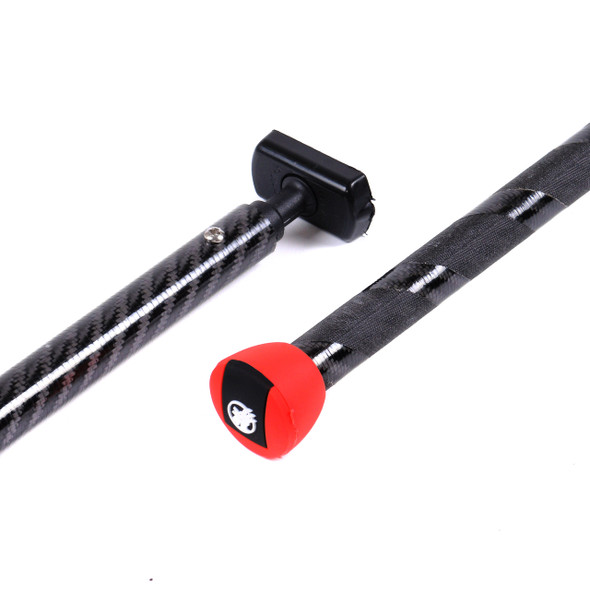
Rooster Carbon Tiller Extension

Rooster Carbon Tiller Extension for RS Aero

Hobie Bravo Tiller Extension (EZ Loc)
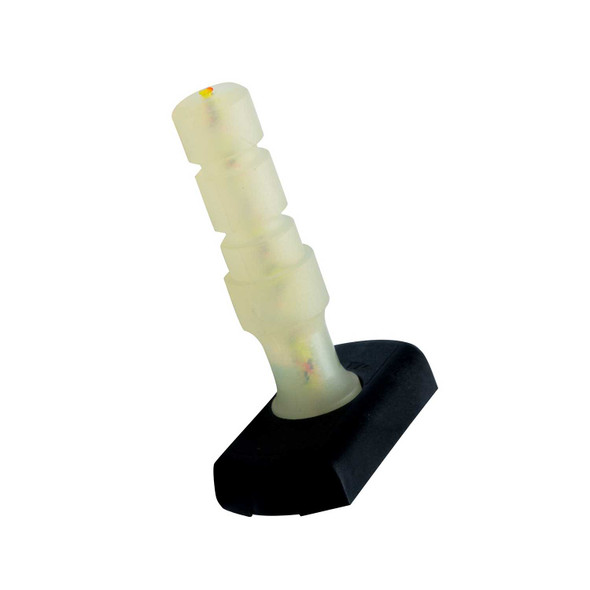
Omniflex Tiller Joint Universal w/ Rope Core

C420 Tiller with Extension

FJ Tiller (Aluminum Complete)
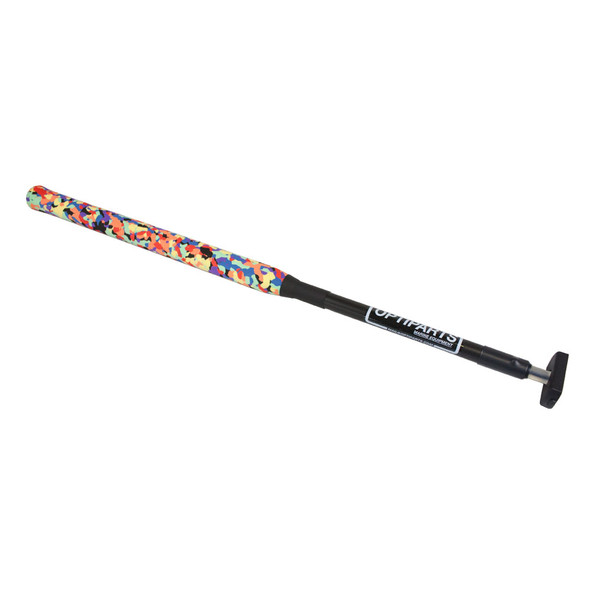
Opti Jamaica Tiller Extension

Opti Tiller (Standard)

Ronstan Battlestick Extension

Omniflex Tiller Joint Universal

Opti Tiller and Extension (Deluxe)

Opti Tiller and Extension (Standard)

Sunfish Tiller w/ Extension
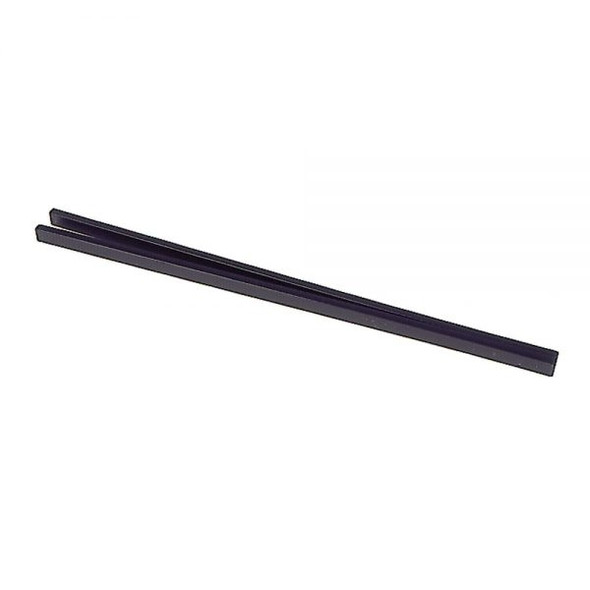
Opti Tiller (Deluxe)

Opti Tiller Extension (Standard)
- Total: items /
- Add all to cart
Adding your products to cart
Subscribe to our newsletter.
Sign up for our newsletter to receive exclusive discounts, new product announcements, and upcoming sales.
- New Sailboats
- Sailboats 21-30ft
- Sailboats 31-35ft
- Sailboats 36-40ft
- Sailboats Over 40ft
- Sailboats Under 21feet
- used_sailboats
- Apps and Computer Programs
- Communications
- Fishfinders
- Handheld Electronics
- Plotters MFDS Rradar
- Wind, Speed & Depth Instruments
- Anchoring Mooring
- Running Rigging
- Sails Canvas
- Standing Rigging
- Diesel Engines
- Off Grid Energy
- Cleaning Waxing
- DIY Projects
- Repair, Tools & Materials
- Spare Parts
- Tools & Gadgets
- Cabin Comfort
- Ventilation
- Footwear Apparel
- Foul Weather Gear
- Mailport & PS Advisor
- Inside Practical Sailor Blog
- Activate My Web Access
- Reset Password
- Customer Service

- Free Newsletter

Ericson 41 Used Boat Review

Mason 33 Used Boat Review

Beneteau 311, Catalina 310 and Hunter 326 Used Boat Comparison

Maine Cat 41 Used Boat Review

Tips From A First “Sail” on the ICW

Tillerpilot Tips and Safety Cautions

Best Crimpers and Strippers for Fixing Marine Electrical Connectors

Thinking Through a Solar Power Installation

Getting the Most Out of Older Sails

How (Not) to Tie Your Boat to a Dock

Stopping Mainsheet Twist

Working with High-Tech Ropes

Fuel Lift Pump: Easy DIY Diesel Fuel System Diagnostic and Repair

Ensuring Safe Shorepower

Sinking? Check Your Stuffing Box

The Rain Catcher’s Guide

Boat Repairs for the Technically Illiterate

Boat Maintenance for the Technically Illiterate: Part 1

Whats the Best Way to Restore Clear Plastic Windows?

Mastering Precision Drilling: How to Use Drill Guides

Giving Bugs the Big Goodbye

Galley Gadgets for the Cruising Sailor

Those Extras you Don’t Need But Love to Have

UV Clothing: Is It Worth the Hype?

Preparing Yourself for Solo Sailing

How to Select Crew for a Passage or Delivery

Preparing A Boat to Sail Solo

On Watch: This 60-Year-Old Hinckley Pilot 35 is Also a Working…

On Watch: America’s Cup

On Watch: All Eyes on Europe Sail Racing

Dear Readers

Chafe Protection for Dock Lines
- Marine Electronics
- Safety & Seamanship
- Systems & Propulsion
The Hunt is on for a Quality, Well-placed Emergency Tiller
Practical sailors search, 10 years in the making, turns up the good, the bad, and the shiny in emergency tillers, but the ideal arrangement still eludes us..

A decade ago, Practical Sailor editors began scouring boat shows for the perfect emergency tiller and an ideal stowage system for it. Little more than a simple lever arm that attaches to the head of the rudder stock, the emergency tiller is the device a sailor relies on in the event a steering cable parts or theres some other steering system failure. Our seemingly simple search turned out to be a nearly fruitless enterprise. Boat after boat fell far short of delivering even an average emergency tiller. Heres a look at our favorites and favorite offenders as well as our criteria for a good emergency tiller and where to keep it.

Ten years ago, Practical Sailor s editors scoured the seasonal boat shows for well-designed emergency tillers. Little more than a simple lever arm that attaches to the head of the rudder stock, these are the devices a sailor relies on when his steering fails-typically when a cable parts. Lloyds of London requires an emergency tiller for certification as do most offshore races. That seemingly simple search turned out to be a nearly fruitless enterprise. Boat after boat fell far short of delivering even an average emergency tiller.
Now, a decade since that study was carried out, it seems as though little has changed. More reliable (but not invulnerable) direct-linkage steering systems are more common, but plenty of new boats still rely on cable-and-sheave steering wheel systems. And there is no shortage of sad, ill-conceived, malformed emergency tillers.
Some of our favorites, and favorite offenders are highlighted on these pages. With luck it, wont take another 10 years for builders to catch on.
Here, for the record, are Practical Sailor s criteria for a good emergency tiller. If you have one on your boat, now is the time to pull it out and see how it compares. If you simply don’t have one, like the Manta 42 catamaran we checked at the Miami Boat Show earlier this year, its a good time to get one.
Easy to Locate . The tiller should be located where it can be grabbed in a few seconds, even in complete darkness. Installation should require no special tools, but if it does, then the tools should also be easy to find, ideally stored with the tiller.
Easy to Install. The top of the rudder stock should be quickly accessible. Access should not require special tools or require deck openings vulnerable to downflooding. Installation should be easily understood and quickly accomplished by anyone.
Simple Design . The tiller should be non-magnetic, ideally of one-part construction. Metal tube sections should offer adequate strength and leverage to withstand worst-case steering loads. The tiller should positively engage with the top of the rudder stock so it wont pull out or fall off. If lines and blocks are required to compensate for lack of leverage, this gear should be stored with the tiller. The tiller should be adaptable to windvane steering or a simple tillerpilot.
Operability. The design should allow good visibility from the helm, and allow full movement of the rudder with little or no modification to the boat and its instruments.
Comfort . The tiller should let the helmsman steer in a comfortable position. Small diameter tubes are undesirable. Over time, tissue compression of more than 30 pounds-force on the tiller hand can lead to undue fatigue. A pair of gloves (stowed with the tiller) will help reduce pressure on the drivers hands.
Durability. A good emergency tiller should require little or no maintenance and last the lifetime of the boat.
- Emergency Tillers in Photos
RELATED ARTICLES MORE FROM AUTHOR

Safeguarding Sailors via Passage Guardian
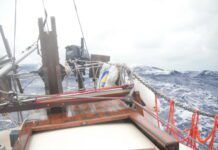
Responding to Emergencies: A Skipper’s Guide for Staying Calm
Leave a reply cancel reply.
Log in to leave a comment
Latest Videos

What’s the Best Sailboats for Beginners?

Why Does A Sailboat Keel Fall Off?

The Perfect Family Sailboat! Hunter 27-2 – Boat Review

Pettit EZ-Poxy – How to Paint a Boat
Latest sailboat review.
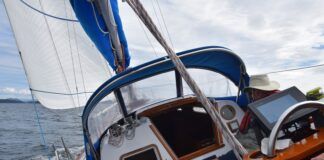
- Privacy Policy
- Do Not Sell My Personal Information
- Online Account Activation
- Privacy Manager
× You are using an outdated browser. Please upgrade your browser to improve your experience.
We Ship Worldwide! | FREE SHIPPING! for US Continental orders over $99. Click for details.

Shopping Cart
Your cart is currently empty..
FREE SHIPPING! for US Continental orders over $99 click for details
Sailboat Tiller Steering & Accessories

A Tiller is a pole that acts as a lever to steer a boat by controlling the rudder. Dinghies and Sportboats use a Tiller Extension in addition to the tiller for better control, while Small Cruising boats are controlled directly by the tiller. All parts and accessories for tiller steering are available. Tiller Extensions, Rudder Heads, Rudder Pintles and Gudgeons and more.
MAURIPRO Sailing, your direct access to Sailboat Tiller Steering & Accessories and all your other sailing and boating needs.
Copyright © 2024 MAURIPRO Sailing LLC.

World Class Rudders, Tillers, and other Gear for Real Life Sailing
Sailboat rudders, sailboat tillers, custom rudders/ tillers, sailboat accessories, rudder repair worksheet, instructional handbook, looking for a product for your sailboat.
Can't Find your Sailboat?
Why Rudder Craft?
At Rudder Craft we build every sailboat rudder with the singular focus of improving your sailboat’s steering performance. In order to accomplish this our sailboat rudders incorporate a hydrofoil design, as a matter of course. Sailboats ranging from the West Wight Potter 15, all the way up to the MacGregor 36 and Catalina 42, will find a more accurate helm once a Rudder Craft hydrofoil sailboat rudder is installed.
Why Hydrofoil?
Operating on principles similar to airplane wings, the foiled sailboat rudder design generates lift as the sailboat makes way. By employing the sailboat rudder to reduce drag, and increasing the force the sailboat rudder is able to exert, any sailboat will find themselves performing better: weather helm is reduced, tacking is crisper, points of sail are easier to keep, and helm effort is greatly reduced in light and moderate air.
Why Use a Kick-up Rudder?
Subscribe to our blog.
Join our mailing list to receive the latest news and updates from our team.
You have Successfully Subscribed!
No results found.
The page you requested could not be found. Try refining your search, or use the navigation above to locate the post.
Blog Coming Soon!
Customer reviews.
A Simple Tiller Tender
Hands-off sailing
From Issue September 2017
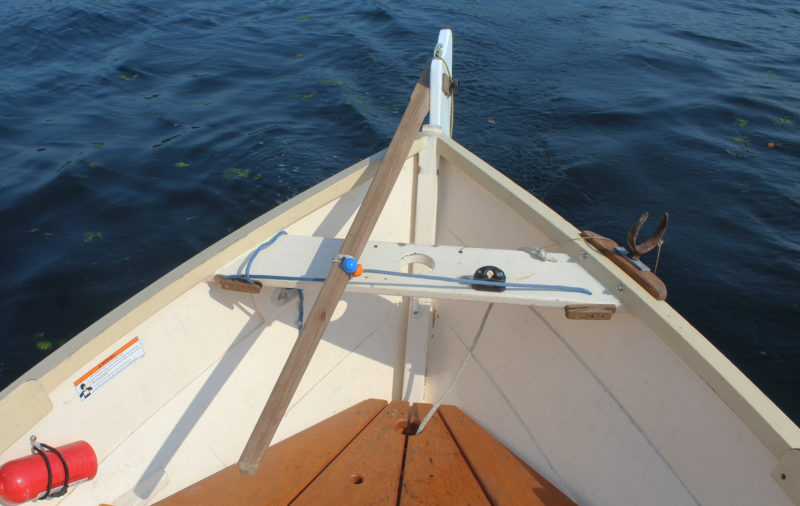
The bungee doesn’t need to be removed to use the tiller. Just push or pull the tiller and the bungee will hold it at the new angle.
I n my years of solo cruising in small boats I’ve found that there are many times when it’s helpful to have both hands free while sailing. I can free one hand by securing mainsheet with a cam cleat or slippery hitch, and then I just need something to hold the tiller in place so I can grab a bite to eat, take a compass bearing, or pull on a jacket.
There are a number of tiller tenders available commercially, but they tend to be bulky, overly complicated, and come at an added expense; from what I’ve seen, many of them also require you to engage and disengage them or adjust their tension.
On a recent cruise, though, my brother showed me a tiller tender that eliminates all those problems. It’s cheap, simple, and utterly reliable. It doesn’t need adjustment and there’s nothing to engage or disengage; you can steer the boat normally with the system in place, and whenever you need to let go of the tiller, it stays where you positioned it.
To set this system up for a conventional tiller, run a line athwartships under your tiller from rail to rail. If your boat has open gunwales or a pair of cleats well aft on the gunwales, you don’t need to add anything to anchor the ends of the line. This line needs to be just taut enough to minimize play in the tiller when the system is in use.
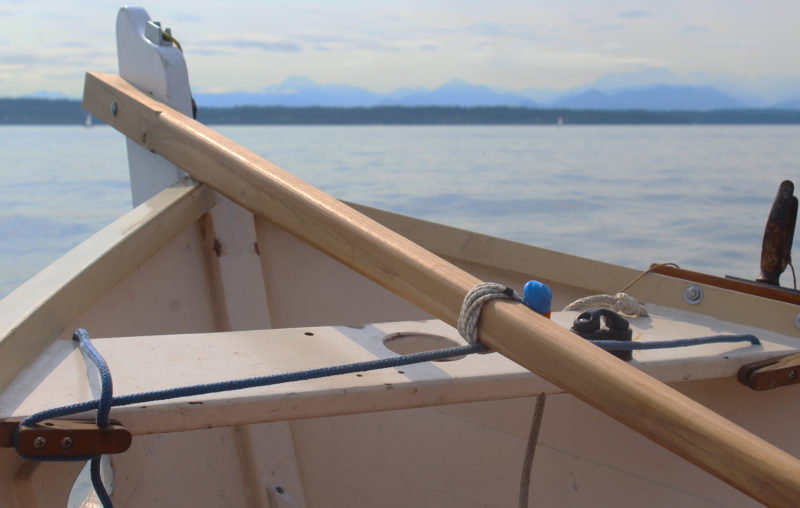
The tiller tender requires only a short line run across the boat under the tiller an toggled bungee loop to squeeze that line to the tiller.
Next, take a short bungee loop with a plastic ball on the end and pass the looped end around both the tiller and the loop you just rigged. Take enough turns with the bungee around both the tiller and the loop of line to pull them tightly together before tucking the plastic ball through the bungee to finish the wrap. You can always adjust the tension if you find the bungee is not tight enough and not providing enough friction to hold the tiller in place, or too tight and making the tiller hard to move.
That’s it. Your tiller tender is ready for action. You will still be able to steer normally, but the friction of the system will hold the tiller in place when you let go. You can set the tiller to hold a steady course or push the tiller hard over to tack or jibe while you tend to the sheets.
After rigging this system on my own boat, I found myself sailing hands-free most of the time, with just a slight nudge of the tiller now and then. I doubt I’ll ever go cruising again, or even daysailing, without having this simple tiller tender in place.
Tom Pamperin is a freelance writer who lives in northwestern Wisconsin. He spends his summers cruising small boats throughout Wisconsin, the North Channel, and along the Texas coast. He is a frequent contributor to Small Boats Monthly and WoodenBoat.
Editor’s note:
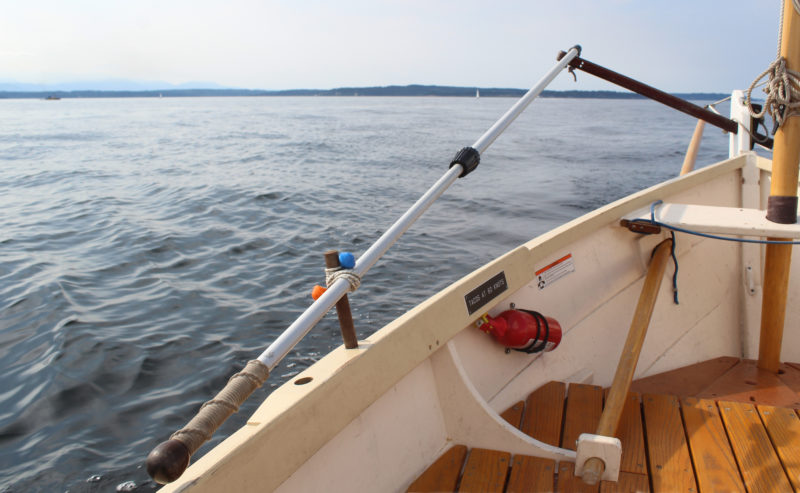
A bungee loop can also be used as a tiller tender on a Norwegian tiller.
To give this system a try, I made a standard tiller that I could attach to the rudder of my Caledonia Yawl (pictured here in the photographs above) and sailed without the mizzen mast in place. I was impressed how well the bungee worked with a standard tiller and wanted to use the same method to create a tiller tender for a Norwegian tiller. I first thought about using the same length of line but set fore and aft instead of athwartships, but a thole pin presented itself as a better place to start. I put the bungee loop over the push-pull tiller and then wrapped it around both tiller and thole.
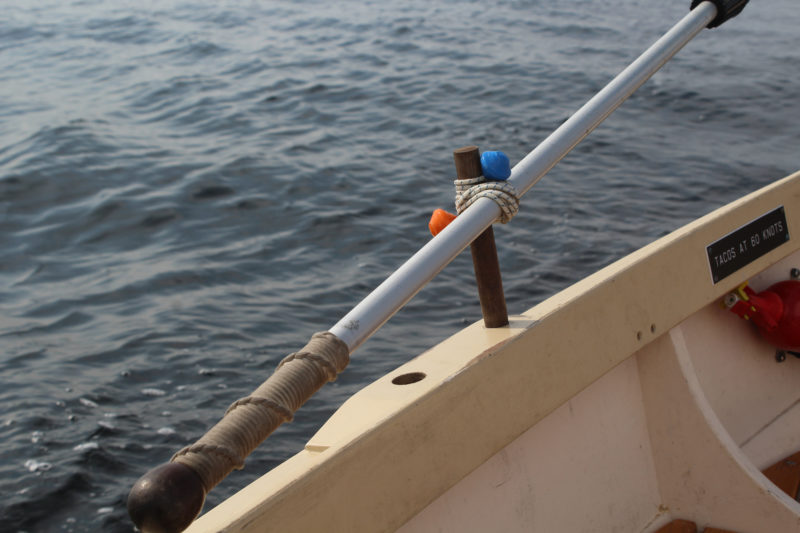
With a Norwegian tiller, the bungee can be looped onto a thole pin or other upright fixture. If the bungee loop has the tiller running through it before it is wrapped, the tiller can be lifted to disengage the tiller tender without loosing the bungee.
That’s all it took, and the bungee worked just as well in this new arrangement. I could change course by pushing or pulling the tiller and leaving it to make the boat come about or hold a straight course. I could also disengage the tiller by lifting it—along with the bungee—from the thole and have complete freedom of motion. The tiller follows me after I tack and gets wrapped with a thole pin on the windward rail.
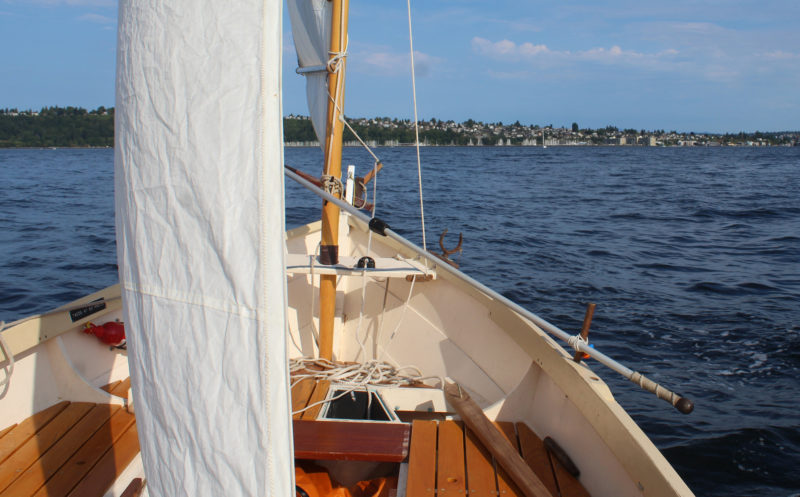
The tiller should be held on the weather rail where it is accessible when the boat heels in a gust.
You can share your tricks of the trade with other Small Boats Monthly readers by sending us an email .
Share this article
Join The Conversation
We welcome your comments about this article. If you’d like to include a photo or a video with your comment, please email the file or link.
Comments (13)
One thing to consider is that the two legs of the line sure look like they are the radii of an ellipse. Accordingly there needs to be some slack in the system to get full range of motion for the rudder, either from the bungees around the tiller, a loose line or by using a bungee-tensioned cross line. The latter is what I have used for a while. The cross line is anchored just ahead of the rudder at small pad eye on the port gunnel, makes a turn through a small shackle attached to the forward part of the rudder, then through a pad eye on the starboard side. A bungee connects the line back to the port pad eye, creating an isosceles triangle when the rudder is centered. It is handy. Having a way to adjust the tension from the bungee is also nice.
Sure glad that wasn’t totally confusing. KISS
Ole thanks for the comment. I’m not sure I follow you about needing a cross line, or about needing adjustments to get full range of motion for the rudder–the system as described is dead simple, and works really well with just an athwartships line and a bungee holding it to the tiller. No need to adjust tension; you can use the tiller normally, but it will stay wherever you leave it when you let go. Works brilliantly.

Ole,thanks. That’s pretty much what I was picturing from your description, then. I think the system described in the article is simpler, though. Once rigged, there is no need to adjust tension in the system at all, and no moving parts (other than the tiller itself), and no hardware. The tight bungee wrapped around the tiller and athwartships line holds the tiller reliably in place (just with friction) whenever you take your hand off the tiller, but you can still steer normally, too, with full range of motion for the rudder. Try it for yourself sometime if you’re curious, and you might well find you like it better.
Or is there some advantage to your system that I’m not seeing? I admit to being biased in favor of simplicity, so maybe there’s something there I haven’t considered. Thanks for the discussion!
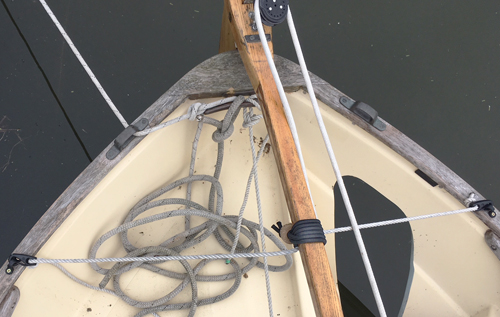
Sorry for the late reply. I’m glad the system is working for you. I have been really happy with how well it works, how simple it is, and how easy it is to rig. I doubt I’ll ever have a boat without it now that I’ve used it for a couple of years.
Brilliant! I like it so much I think I might remove my regular factory-made tiller tamer and use yours instead, because it allows convenient “foot-tillering”, while not having to use either hand to disengage and then re-engage the taming mechanism.
This is great! I used to just tie the tiller to an horizontal line every time I need my hands free. The idea of the bungee is definitely worth a try. 🙂
Yes, it works really well as described. The one drawback I’ve discovered is that the friction does wear out the bungee loop eventually. Depending how often you sail, you might find yourself replacing it every year, or even several times a year. Still cheap, though.
Tacos at 60 knots? LOL, just happened to notice the plate mounted on the gunnel on the CY
That plate caught the eye of one of our other readers in a photo in my review of the Gas One Mini stove. Here’s the reply I posted:
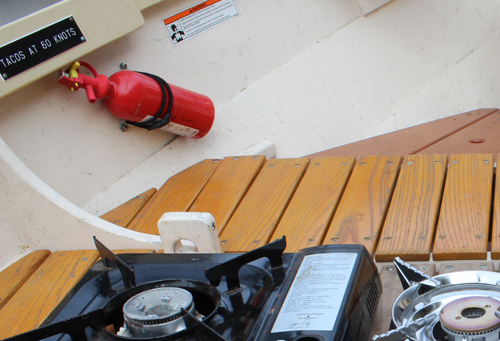
Great story. Thanks for sharing and clearing up that inside joke. Best regards and Happy Holidays!
Leave a Reply Cancel reply
Your email address will not be published. Required fields are marked *
Stay On Course
More From This Issue

From The Editor
A Leeboard for a Motorboat
Our canal boat, BONZO, wanders in the wind like on off-leash dog. The design, Phil Thiel’s Escargot, is intended for narrow waters that aren’t likely to be subject to breezes,…
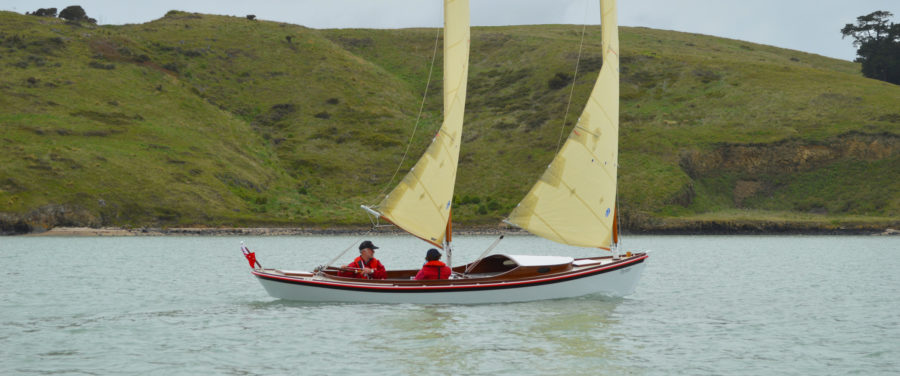
Boat Profile
The diminutive yacht OYSTER, a Milford 20, is a modern take on the early New Haven sharpies that worked the oyster beds along Long Island Sound’s Connecticut shores. Inspired by…
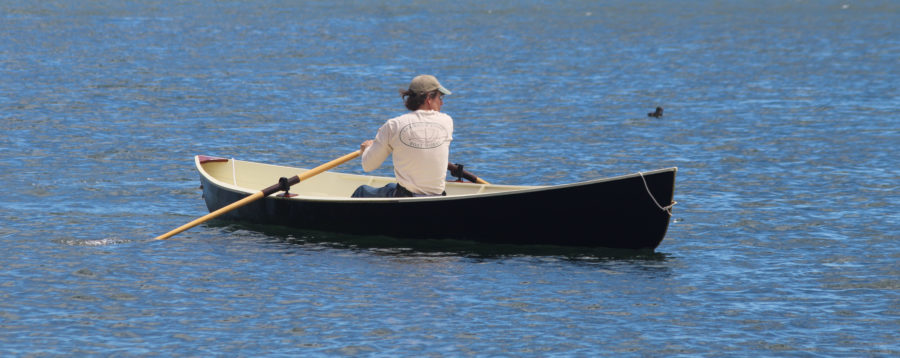
Drake Raceboat
Clint Chase of Chase Small Craft wrote of the Drake Raceboat: “This was the first boat that I designed totally from the numbers.” It’s the third in his series of…

The Texas 200
The chop stirred up the bottom across miles of shallows, turning the water gold under the midday sun. I closed on the windward shore until I was in calmer water,…
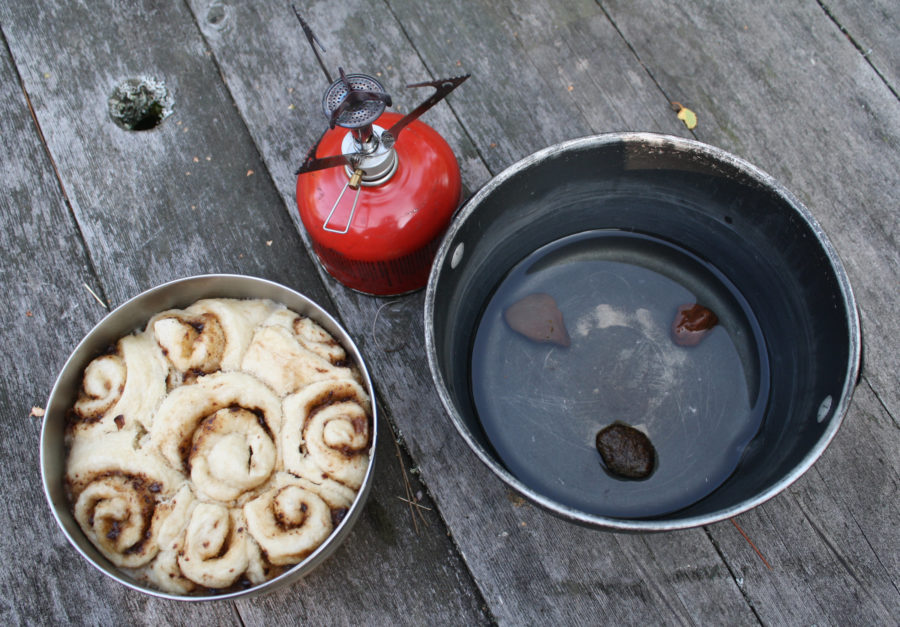
Back-Country Baking
I once looked forward to camp sweets just as much as our young daughters do now. Pineapple-cherry dump cake baked in a Dutch oven was a staple of my Boy…
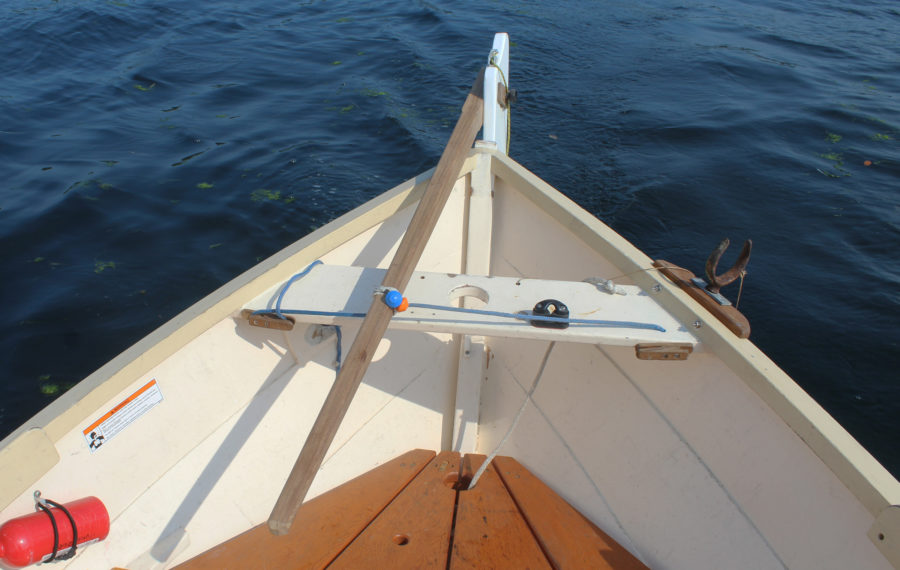
In my years of solo cruising in small boats I’ve found that there are many times when it’s helpful to have both hands free while sailing. I can free one…
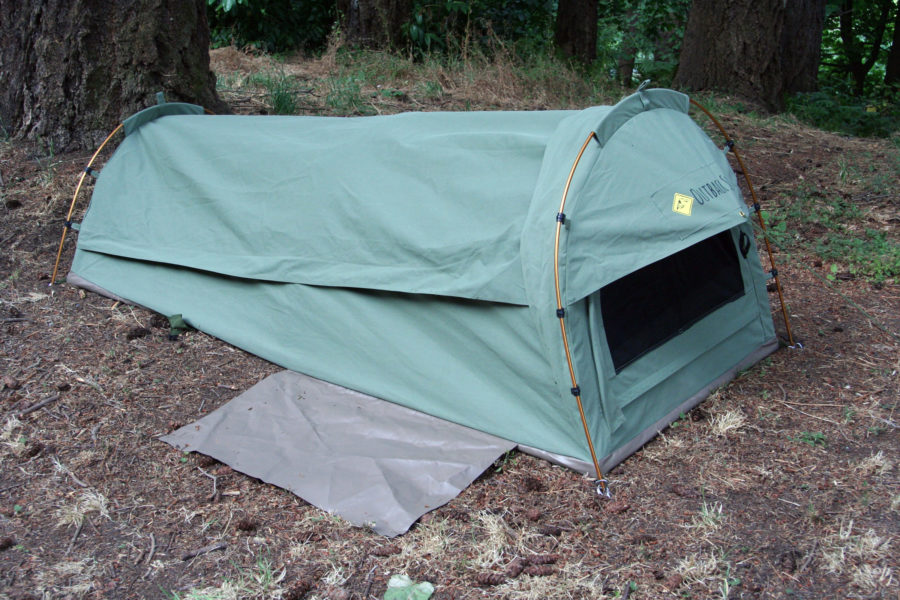
Product Reviews
Pioneer Swag Tent
The nights I slept in the Outback Swag Tent, I was just camped in the back yard. After one night in it I had the information I needed and could…
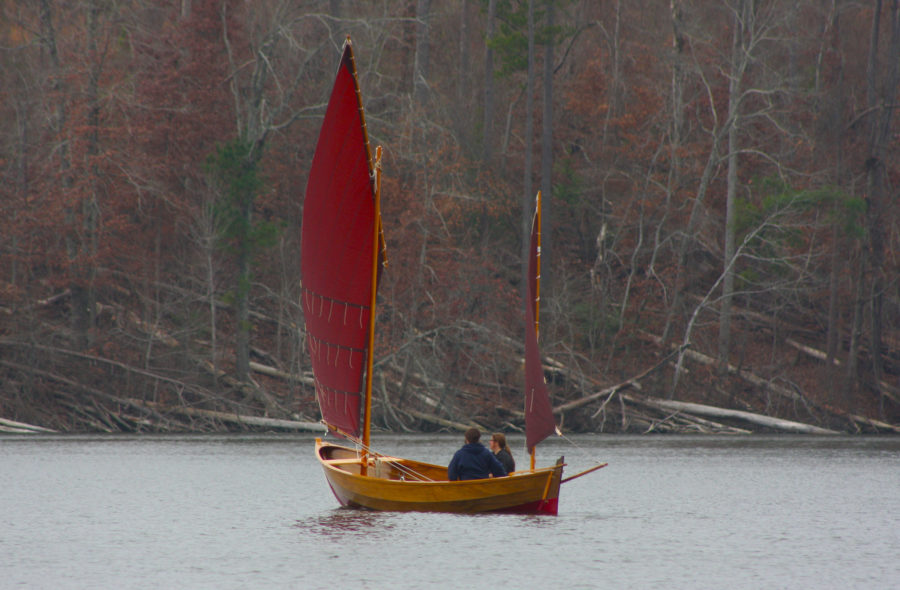
Caledonia Yawl
Reader Built Boats
At the ramp, GYPSY SOUL slipped into the water for the first time. Scotty and Juilio hadn’t sailed a lug rig before, but hauled in the main sheet and took…
More Technique
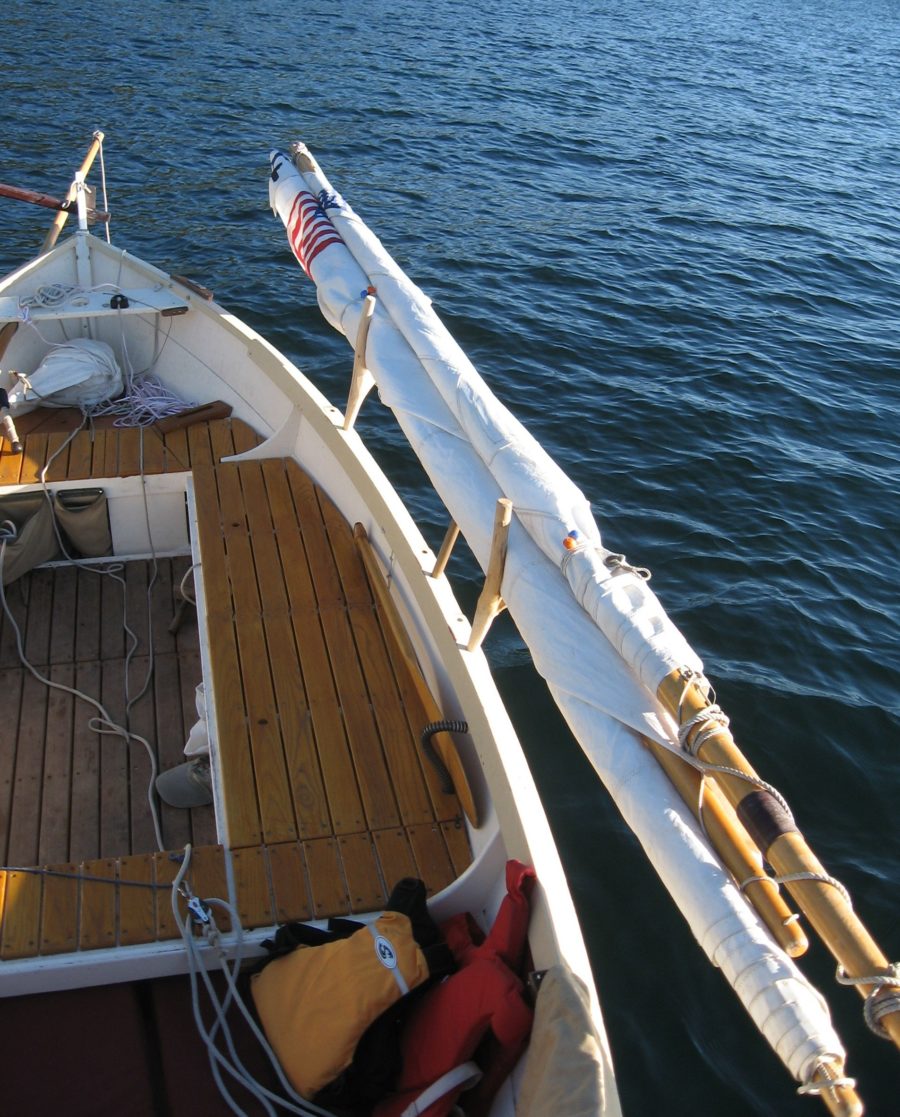
Stowing oars and spars
Oars, masts, and spars get you where you want to go in a small boat built for rowing and sailing, but those long sticks are awkward to stow when they’re…
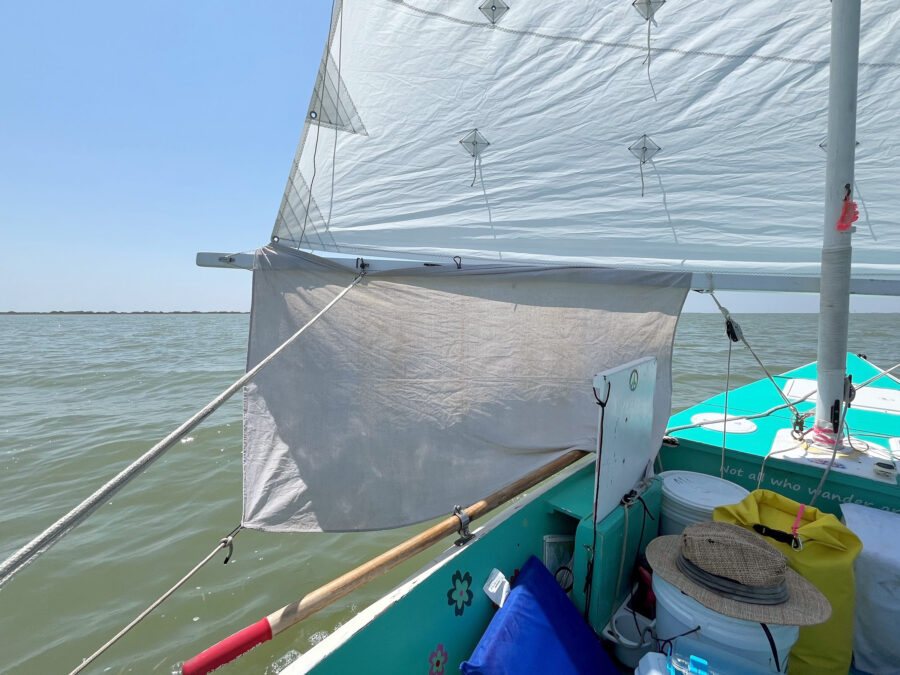
Water-Sails for Small Boats
My experience with water-sails started when I was on a multi-day camp-cruising trip about five years ago, and I had a long downwind leg to sail one morning in very…
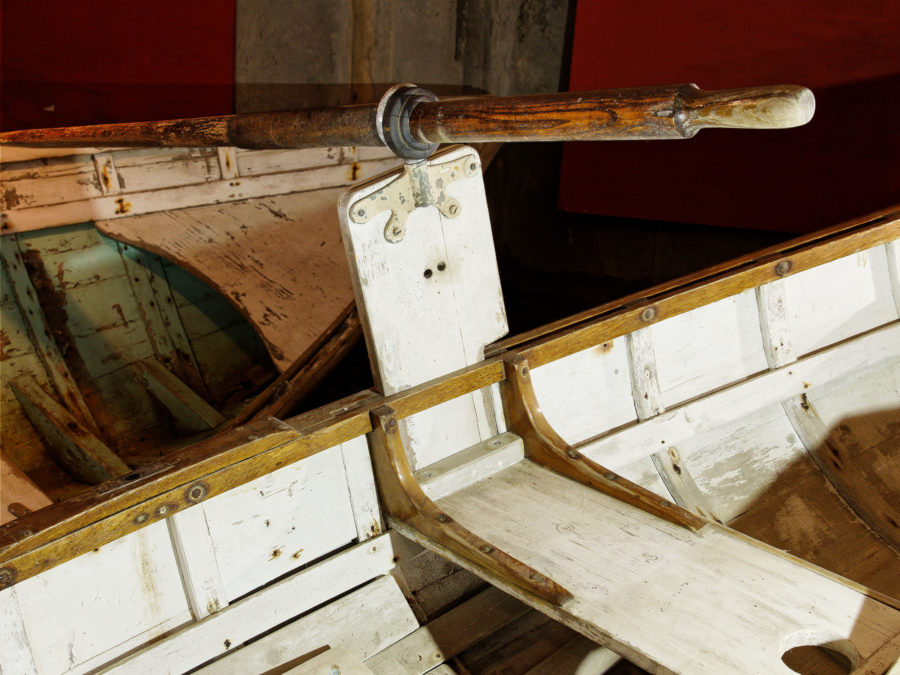
Oarlock Extensions
The choice of extensions, their height and mounting, is going to vary depending on your boat. The easiest modification is a fabricated metal tube and rod or cast lock system.…
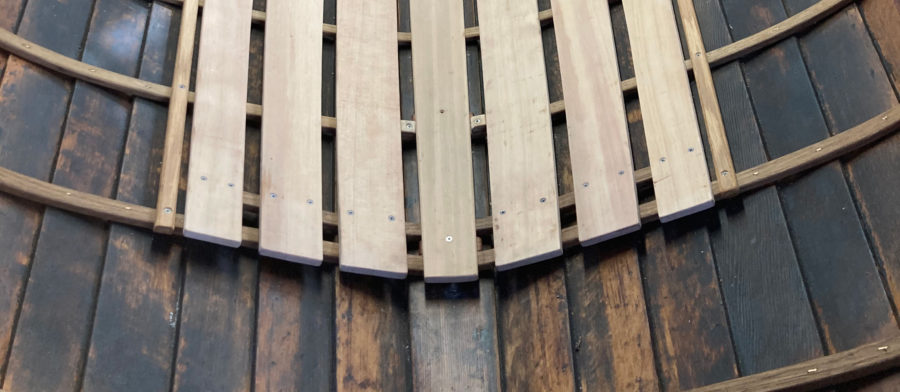
Removable Floorboards
While it may be common practice with plank-on-frame construction of this sort to fasten floorboards to the ribs, the floorboards are then a nuisance to remove, and repeated removal of…
Subscribe Today!
Become a subscriber today and you’ll recieve a new issue every month plus unlimited access to our full archive of backlogged issues.
Already a subscriber? Sign In
Subscribe For Full Access
Flipbooks are available to paid subscribers only. Subscribe now or log in for access.

2025 Lund 1600 Fury Tiller
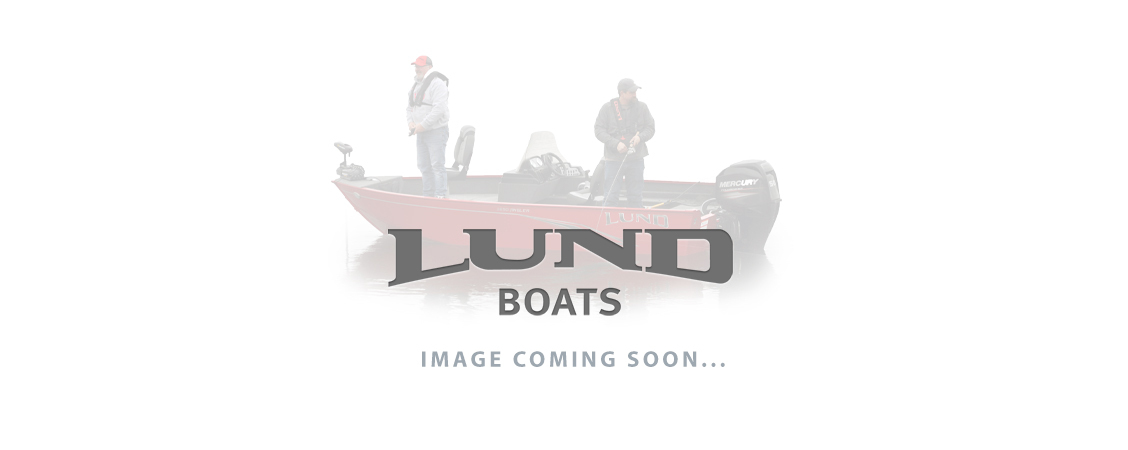
Boat Details
New 2025 lund 1600 fury tiller fishing boat for sale near lake bomoseen, vt.
This New 2025 Lund 1600 Fury Tiller Fishing Boat is for sale at Woodard Marine located near Lake Bomoseen, Vermont. CONTACT Woodard Marine today for more information. If this isn't the exact Lund Fishing Boat you're looking for don't hesitate to go back and REVISE YOUR SEARCH . We're sure to have the perfect Fishing Boat for you at our showroom in Vermont where we host a large selection of new and used Boats for sale. We carry Cruising, Fishing and Pontoon boats, Wake/Ski/Surf Boats and Personal Watercrafts for sale in the Lake Bomoseen area. Visit Woodard Marine, your VT Marine Dealership. Vermont’s premier new & used Marine Dealer, we'll help you home with a new Lund Fishing Boat today!
Woodard Marine
Map Directions: 53 E Creek Dr, Castleton, VT 05735
Click to Call: (802) 265-3690
Features & Options
- Freight & Water Ready
- Complete Vinyl Floor
- Bow Trolling Motor Harness w/Plug
- Heated Grip Handle
- Prop-Standard Aluminum Prop
- Helix 5 Fish Finder (console Mount)
- Minnkota 12v 55lb V2 Trolling Motor
- 2 Bank Onboard Charger
- Fuel Tank 6 gallon Portable w/Fuel Hose
- Fuel Tank Hider
- Load Guides
- Travel Cover
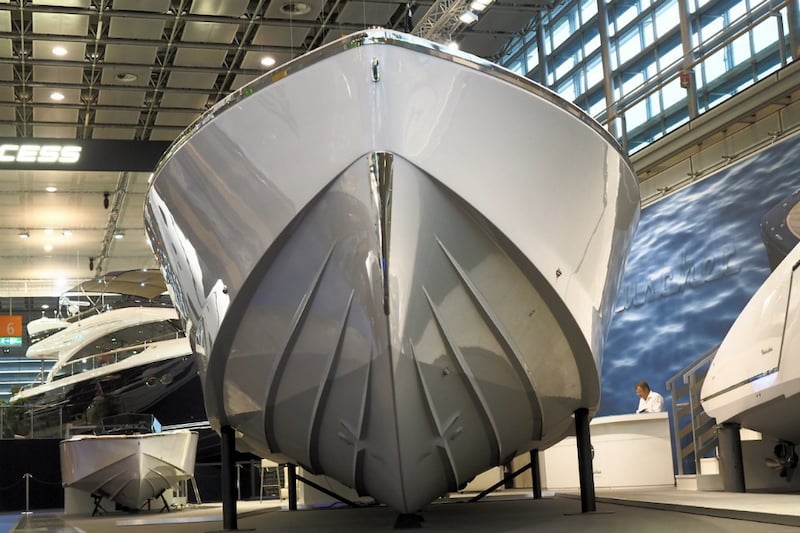
Agreed Hull Value
Make it mine, need a financing, apply a trade-in value, need insurance.

Schedule an Appointment
Boats you might also like.
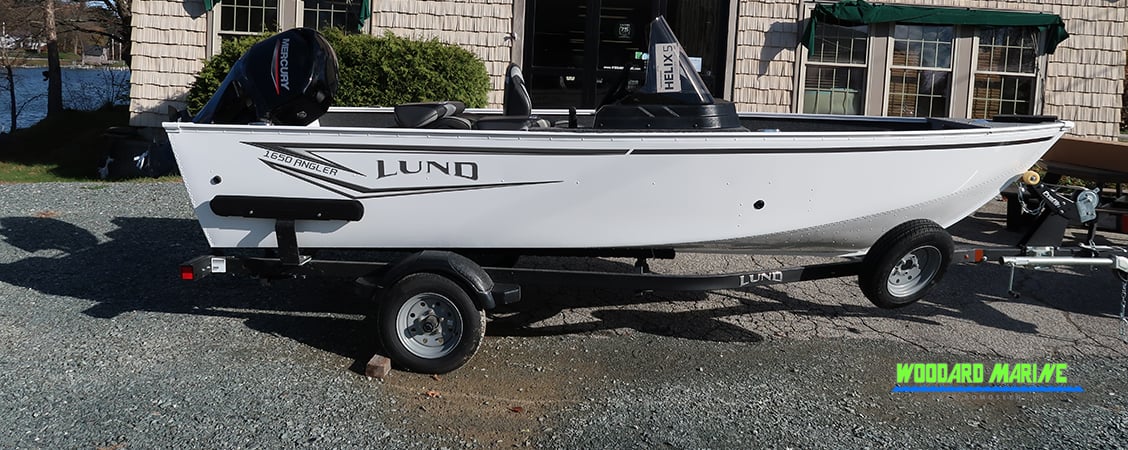
2024 Lund 1650 Angler SS
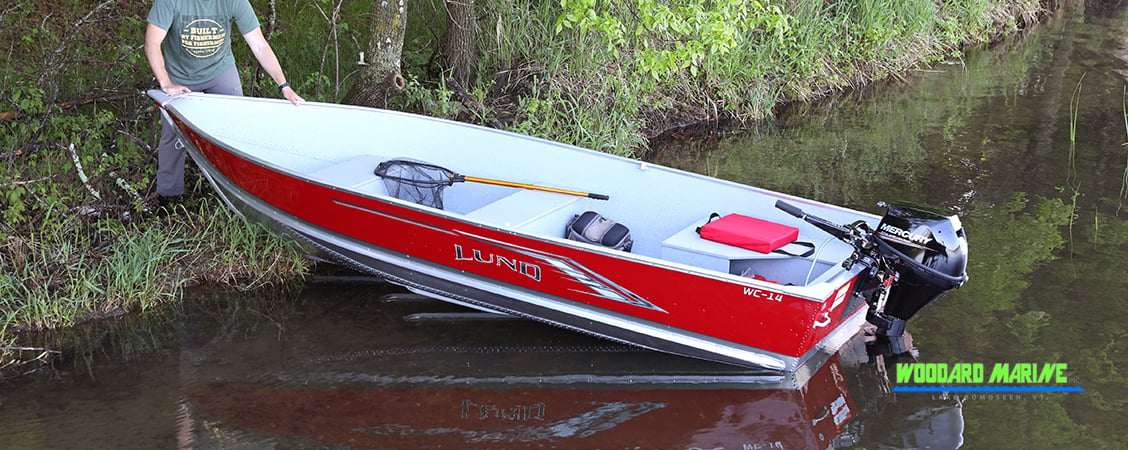
2024 Lund WC-14 Fishingboat
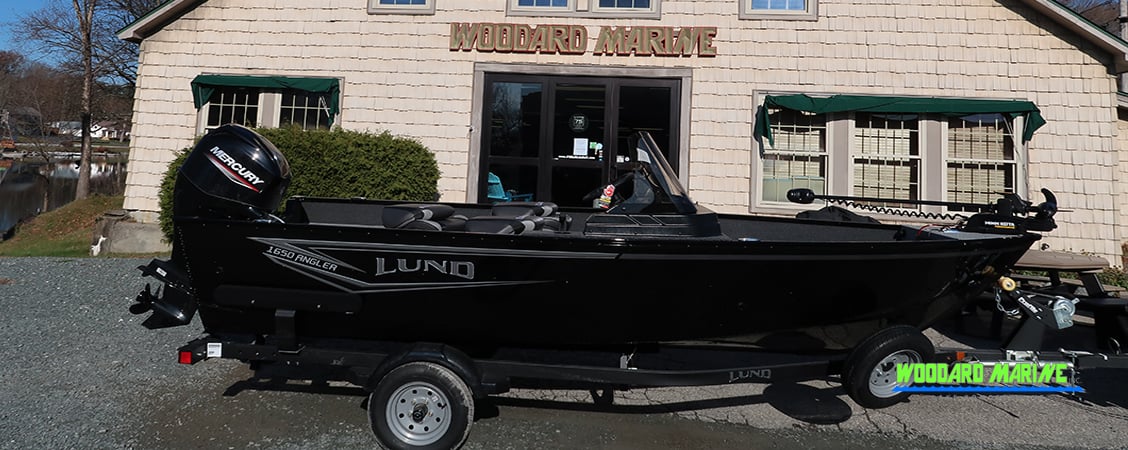

Please verify you are a human
Access to this page has been denied because we believe you are using automation tools to browse the website.
This may happen as a result of the following:
- Javascript is disabled or blocked by an extension (ad blockers for example)
- Your browser does not support cookies
Please make sure that Javascript and cookies are enabled on your browser and that you are not blocking them from loading.
Reference ID: 19ae566c-65e4-11ef-8dc8-3c7bde82bba2
Powered by PerimeterX , Inc.

IMAGES
VIDEO
COMMENTS
The sailboat tiller is like a captain's rudder, steering you towards new horizons and adventures. This essential piece of equipment controls the movement of your sailboat and allows you to navigate through the water with confidence. But fear not! Using a sailboat tiller is simpler than tying a sailor's knot. Step 1: Feel the Tiller in Your ...
Add timeless beauty and refined steering to your sailboat with a handcrafted, laminated tiller now offered as the perfect companion to WaveFront's flagship tiller-steering device, the TillerClutch. Our tillers come with a three-year limited warranty and are built from the best hardwoods for proven strength and durability. The laminated strips ...
Welcome Sailors! THIS IS THE HOME OF WOOD SAILBOAT TILLERS. WE OFFER QUALITY TILLERS FOR MANY BOAT MODELS SUCH AS CATALINA, HUNTER, J-BOAT, PEARSON, AND MORE. CUSTOM TILLERS ARE ALSO AVAILABLE. OUR TILLERS ARE BEING USED AROUND THE WORLD BY ALL TYPES OF SAILING ENTHUSIASTS INCLUDING DAY SAILORS, LONG TRIP CRUISERS, AND COMPETITIVE RACERS.
Tiller pilots have their place. I use one, when any of mine are working, to sail with an asymmetrical; in extremely light wind; and when the wind is strong and aft, sailing under jib alone or bare poles. But that's it. At practically no expense you have freed yourself from the tyranny of the tiller. And tiller pilots. - - -
Steering with the Tiller & Rudder: Free Online Sailing Lessons. Part of the series: How to Sail a Boat. Learn how the tiller is used to turn the rudder and s...
The tiller is a lever that you use to turn the rudder to steer a boat. On many power and sailboats, the rudder (s) are out of sight beneath the hull. For this type of design, the tiller is fitted to a post. The post is attached to the rudder, and it is fitted under the boat. When steering with a tiller, it is moved opposite of the direction you ...
Admittedly, centre cockpit designs have to be wheel steered owing to the distance between the helming position and the rudder. And so do large heavy displacement designs where the tiller would need to be inconveniently long. On a heavy-displacement, centre-cockpit sailboat like this Whitby 42, wheel steering is the only option.
Tiller: A tiller is a simple lever mostly used for steering smaller sailboats. It's typically a horizontal bar attached directly to the boat's rudder. When you push the tiller to port (the left side of the boat as you look forward), the boat turns to starboard, and vice versa. Tiller steering provides direct control and feedback from the ...
A tiller is a lever used to steer a sailboat. It connects directly to the rudder, allowing the sailor to control the direction of the boat. The tiller is typically made of wood or metal and is positioned at the aft of the vessel for easy access and maneuverability.
A Boat's Tiller. A tiller is essentially a pole attached to the top of a rudder, It acts as a lever to directly pull or push the rudder. The rudder is a vertical, underwater blade positioned at the vessel's stern, which can be moved to the left or right by the tiller. The rudder steers by redirecting water past the hull, creating turning ...
Sailboat Rudder and Tiller Hardware: Pintles, Gudgeons, and More Fisheries Supply is a premier supplier of high-quality sailboat tillers, rudder pintles, gudgeons, and steering hardware from top brands. Pintles and Gudgeons Gudgeon and pintle are the hinging mechanism for outboard-mounted rudders.
Sailboat Racing Tips: Tiller Extension Technique. The feel on the tiller extension is your direct link to the boat's performance, so how you hold it is more important than you might think. By Mike ...
World-class laminated tiller for your sailboat. Rudder Craft tillers are built in-house from top quality wood selected for its strength and beauty. Eight strips of laminated African mahogany and white ash are glued in Rudder Craft's proprietary molds to produce tillers for specific boat models. The butt end dimensions are 2" H x 1 1/2" W.
(Best for Tiller-steered Sailboats) The Raymarine ST100 Plus Tiller Pilot is a classic tiller pilot that's one of the best accessories for your sailboat and your everyday sailing escapades. It's designed in such a way that it can accept NMEA data while still offering accurate navigation thanks to its incredibly intelligent software.
Rudder Craft Varnished Sailboat Tiller - Stock 'F' Tiller $191.99. 0. Barton Bottom Rudder Gudgeon $15.56 - $17.81. Barton Carbon Fiber Tiller Extension $158.40 - $196.20. Lewmar Tiller Lever $276.99 - $366.99. Barton Golf Grip Carbon Fibre Tiller Extension $86.53 - $117.17. 0 Filters. Manufacturer . Barton ...
Simrad Tillerpilot TP10. SKU: TP10. The TP10 delivers reliable auto steering for boats with tillers up to 32ft in length. Simple, straightforward controls and a precise steering system - normally only found on higher-end models - combines in a quiet package with extremely low power draw to allow sailors a safe passage in coastal waters.
Rooster Carbon Tiller Extension for RS Aero. Rooster Sailing. $149.00. The Rooster RS Aero Carbon Tiller Extension - 1.1m long (22mm diameter tube). This extension comes complete with a RWO Omniflex rubber universal joint. This joint is easily replaced if you have a different fitting on your tiller The length...
A decade ago, Practical Sailor editors began scouring boat shows for the perfect emergency tiller and an ideal stowage system for it. Little more than a simple lever arm that attaches to the head of the rudder stock, the emergency tiller is the device a sailor relies on in the event a steering cable parts or theres some other steering system failure.
Sailboat Tiller Steering & Accessories. A Tiller is a pole that acts as a lever to steer a boat by controlling the rudder. Dinghies and Sportboats use a Tiller Extension in addition to the tiller for better control, while Small Cruising boats are controlled directly by the tiller. All parts and accessories for tiller steering are available.
At Rudder Craft we build every sailboat rudder with the singular focus of improving your sailboat's steering performance. In order to accomplish this our sailboat rudders incorporate a hydrofoil design, as a matter of course. Sailboats ranging from the West Wight Potter 15, all the way up to the MacGregor 36 and Catalina 42, will find a more ...
This line needs to be just taut enough to minimize play in the tiller when the system is in use. The tiller tender requires only a short line run across the boat under the tiller an toggled bungee loop to squeeze that line to the tiller. Next, take a short bungee loop with a plastic ball on the end and pass the looped end around both the tiller ...
Because manufacturers often changed tiller and/or rudder specifications mid-production and boat owners repair or replace tillers and rudders over the life of the boat, a new tiller may not simply bolt on. Most of our tillers have butt end measurements of 2"H x 1 1/2"W. Compare the butt dimensions of our tillers with your existing tiller before ...
New 2025 Lund 1600 Fury Tiller Fishing Boat For Sale Near Lake Bomoseen, VT. This New 2025 Lund 1600 Fury Tiller Fishing Boat is for sale at Woodard Marine located near Lake Bomoseen, Vermont. CONTACT Woodard Marine today for more information. If this isn't the exact Lund Fishing Boat you're looking for don't hesitate to go back and REVISE YOUR ...
REWARDS. 1400 NW 45th Street , Seattle WA 98107. home. categories. sailing. sailboat steering. tillers & tillers extensions. Check your spelling or try fewer, more generic words. If you're really stuck, visit the.